However, according to other accounts
,
it was the giant Typhoeus who was buried beneath the volcano.
In Greek
Mythology Titans were
a race of powerful deities who were overthrown by the Olympian
gods when they came to power. In Disney's Hercules,
theTitans are
portrayed as four elemental monsters who terrorized Ancient
Greece. They were the physical manifestation of the element they
controlled. These "Titans" were original creations for the film. Hercules:
The Animated Series, which expands on the Greek
Mythological setting and addresses many of the movie's
inaccuracies and omissions, featured Titan characters from
actual Greek Mythology.
In Greek
mythology, the Titans (Greek: Τιτάν—Ti-tan;
plural: Τιτᾶνες—Ti-tânes)
were a primeval race of powerful deities,
descendants of Gaia (Earth)
and Uranus (Heaven),
that ruled during the legendary Golden
Age. They were immortal huge
beings of incredible strength and stamina and were also the
first pantheon of
Greco-Roman gods and goddesses.
In the first generation of twelve Titans, the males were Oceanus, Hyperion, Coeus, Cronus, Crius and Iapetus and
the females - the Titanesses - were Mnemosyne, Tethys, Theia, Phoebe, Rhea and Themis.
The second generation of Titans consisted of Hyperion's children Eos, Helios,
and Selene;
Coeus's daughters Leto and Asteria;
Iapetus's children Atlas, Prometheus, Epimetheus,
andMenoetius;
Oceanus' daughter Metis;
and Crius's sons Astraeus, Pallas,
and Perses.
The Titans were overthrown by a race of younger gods, the Olympians,
in the Titanomachy ("War
of the Titans"). This represented a mythological paradigm
shift that the
Greeks may have borrowed from the Ancient
Near East.[1]
Greeks of the classical age knew of several poems about
the war between the Olympians and Titans. The dominant one, and
the only one that has survived, was in the Theogony attributed
to Hesiod.
A lost epic, Titanomachia—attributed
to the legendary blind Thracian bard Thamyris—was
mentioned in passing in an essay On
Music that was
once attributed to Plutarch.
The Titans also played a prominent role in the poems attributed
to Orpheus.
Although only scraps of the Orphic narratives
survive, they show interesting differences with the Hesiodic
tradition.
The Greek myths of the Titanomachy fall into a class of similar
myths throughout Europe and
the Near East concerning a war in heaven, where one generation
or group of gods largely opposes the dominant one. Sometimes the
elders are supplanted, and sometimes the rebels lose and are
either cast out of power entirely or incorporated into the pantheon.
Other examples might include the wars
of the Æsir with
the Vanir and Jotuns in Scandinavian
mythology, the Babylonian epic Enuma
Elish, the Hittite "Kingship
in Heaven" narrative, the obscure generational conflict in Ugaritic fragments,
and the rebellion of Lucifer in Christianity.
The Titanomachy lasted for ten years.
Hesiod does not, however, have the last word on the Titans.
Surviving fragments of poetry ascribed to Orpheus preserve
some variations on the myth. In such text, Zeus does
not simply set upon his father violently. Instead, Rhea spreads
out a banquet for Cronus so that he becomes drunk upon fermented
honey. Rather than being consigned to Tartarus,
Cronus is dragged—still drunk—to the cave of Nyx (Night),
where he continues to dream throughout eternity.
Another myth concerning the Titans that is not in Hesiod
revolves around Dionysus.
At some point in his reign, Zeus decides to give up the throne
in favor of
the infant Dionysus,
who like the infant Zeus is guarded by the Kouretes.
The Titans decide to slay the child and claim the throne for
themselves; they paint their faces white with gypsum, distract
Dionysus with toys, then dismember him and boil and roast his
limbs. Zeus, enraged, slays the Titans with his thunderbolt; Athena preserves
the heart in a gypsum doll, out of which a new Dionysus is made.
This story is told by the poets Callimachus and Nonnus,
who call this Dionysus "Zagreus",
and in a number of Orphic texts, which do not.
One iteration of this story, that of the Late
Antique Neoplatonist philosopher Olympiodorus,
recounted in his commentary of Plato's Phaedrus,[2]affirms
that humanity sprang up out of the fatty smoke of the burning
Titan corpses. Pindar, Plato and Oppian refer
offhandedly to man's "Titanic nature". According to them, the
body is the titanic part, while soul is
the divine part of man. Other early writers imply that humanity
was born out of the malevolent blood shed by the Titans in their
war against Zeus. Some scholars consider that Olympiodorus'
report, the only surviving explicit expression of this mythic
connection, embodied a tradition that dated to the Bronze Age,
while Radcliffe Edmonds has suggested an element of innovative allegorized improvisation
to suit Olympiodorus' purpose.[3]
Some scholars of the past century or so, including Jane
Ellen Harrison, have argued that an initiatory or shamanic ritual
underlies the myth of Dionysus'
dismemberment and cannibalism by the Titans.[where?] She
also asserts that the word "Titan" comes from the Greek τιτανος,
signifying white earth, clay or gypsum, and that the Titans were
"white clay men", or men covered by white clay or gypsum dust in
their rituals.[where?] M.
L. West also asserts this in relation to shamanistic initiatory
rites of early Greek religious practices.[4]
According to Paul
Faure, the name "Titan" can be found on Linear
A written as
"Tan" or "Ttan", which represents a single deity rather than a
group.[5] Other
scholars believe the word is related to the Greek verb τείνω (to
stretch), a view Hesiod himself appears to share: "But their
father Ouranos, who himself begot them, bitterly gave to them to
those others, his sons, the name of Titans, the Stretchers, for
they stretched out their power outrageously."[6]
NOTE:
In recent history, Jerry Wills, an
archeaologist (in 2012) reported that he had just heard about a
group of Giants being uncovered under the ground when the Greeks
were digging a tunnel for a subway rail train.
In the grave tomb, the giants were laid out, dressed in
royal war clothing, and were 16 feet tall. Evidently the
soldiers had been killed in war and given a royal burial for
their efforts to the King.
TUESDAY, JUNE 26, 2012, 3:29 PM
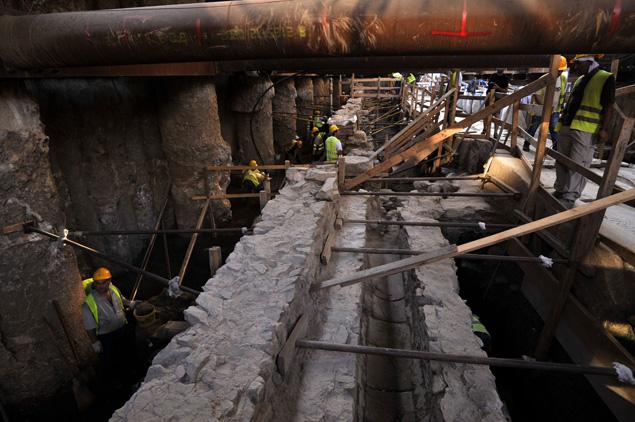
Archaeologists in Greece’s second-largest city have
uncovered a 70-meter section of an ancient road built by the
Romans.
Archaeologists have unearthed a section of an 1,800-year-old
road during a subway construction project in Greece’s
second-largest city.
The ancient marble-paved pathway, built by Romans, is
believed have been the city of Thessaloniki’s main travel
artery almost 2,000 years ago.
Several of the large marble stones discovered featured marks
from wheels of horse-drawn carts. Others were inscribed with
children’ s board games.
Archeologist Viki Tzanakouli said that excavators also found
remains of an older road, built by ancients Greeks 500 years
earlier, under the 70-meter section of the Roman road.
“We have found roads on top of each other, revealing the city's
history over the centuries," Tzanakouli told the Associated
Press. "The ancient road, and side roads perpendicular to it
appear to closely follow modern roads in the city today."
The roads were discovered 23 feet below ground in the center of
the northern port city.
Bases of marble columns, tools and lamps were also uncovered at
the site.
The excavated area was opened to the public Monday, as the city
announced a plan to raise the ancient roads and place them on
permanent display when the subway opens in 2016.
Subway construction is often a slow process in Greece because
workers frequently stumble upon ancient artifacts during
construction.
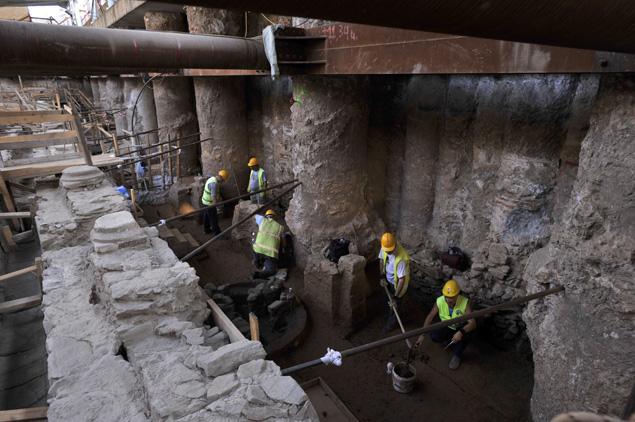
The marble-paved road will be raised to be put on permanent
display for passengers when the subway opens.
Workers began building Thessaloni’s new subway system in 2006
but are already four years behind schedule due to both Greece’
financial crisis and excavation delays.
In 2008, workers unearthed more than 1,000 graves filled with
jewelry, coins, and other objects while building a section of
the underground railway.
The new subway system is expected to begin operating in 2016
with 13 stations, with 10 more stations to be added after.
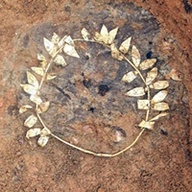
Another Ancient Gold Wreath Found in Greek Subway Construction.
According to the Greek Reporter, the wreath was found “inside a
large box-type Macedonian tomb on the head of a buried female
body.” It was approximately dated to the Early Hellenistic Era,
at the end of the fourth — early third century B.C. Gold wreaths
are rare finds and are usually associated with royal or
aristocratic graves. About 23,000 artifacts have been unearthed
during the dig for the Thessaloniki subway system.
An abundance of gold wreaths appear to lay hidden in a subway
network in Greece.
Indeed, excavation work during construction of a new subway in
the northern city of Thessaloniki, Greece’s second largest city,
has revealed another gold wreath – the ninth since work started
in 2006.
Found on the site of an ancient cemetery at what will be the
Dimokratias Station stop, the wreath of olive
leaves lay buried
for some 2,300 years.
PHOTOS: Accidental Archaeological Discoveries
According to the Greek Reporter, the wreath was found “inside a
large box-type Macedonian tomb on the head of a buried body.”
It was approximately dated to the Early Hellenistic Era, at the
end of the fourth — early third century B.C.
Gold wreaths are rare finds and are usually associated with
royal or aristocratic graves. Featuring delicate decorations
which imitated various leaves, such as oak, olive, vine, laurel
and myrtle, the fragile gold wreaths were created primarily to
be buried.
NEWS: Prehistoric Fossil May Have Inspired Greek Myths
In 2008 archaeologists found eight Hellenistic era golden
wreaths again during subway work in Thessaloniki. The wreaths
were placed within a female burial along with
elaborately-crafted earrings and other artifacts.
About 23,000 ancient and medieval artifacts have been unearthed
during the ongoing dig for the Thessaloniki subway system.
Much-delayed, the project is scheduled for completion in 2017.
Image: This photo, released by the Greek Ministry of Culture
in 2008, shows one of the gold wreaths unearthed at that time.
Credit: Greek Ministry of Culture.
Subway construction workers
in Thessaloniki, Greece, have uncovered a golden olive branch
that dates back approximately 2,300 years. Located at what will
someday be the Republic Station stop, the wreath was found
inside a large, box-like Macedonian tomb — and it was still on
the head of a buried female body. The beautifully preserved
wreath dates back to the Early Hellenistic Period, at the end of
the Fourth to early Third Century B.C.E.
Thessaloniki is the second largest city in Greece and was
founded back in 315 B.C.E by King Cassander of Macedon and named
after his wife Thessalonike — the half-sister of Alexander the
Great.
The discovery was confirmed by
K.B. Misailidou, Director of 16th Ephorate of Prehistoric and
Classical Antiquities. And amazingly, it’s now the ninth wreath
to be uncovered during these subway excavations (which started
back in 2008).
1,000 ancient graves from Thessaloniki
Ancient Graves Found in Greece
ATHENS, Greece (AP) — Greek workers discovered around
1,000 graves, some filled with ancient treasures, while
excavating for a subway system in the historic city of
Thessaloniki, the state archaeological authority said
Monday.
Some of the graves, which dated from the first
century B.C. to the 5th century A.D., contained jewelry,
coins and various pieces of art, the Greek
archaeological service said in a statement.
Thessaloniki was founded around 315 B.C. and
flourished during the Roman and Byzantine eras. Today it
is the Mediterranean country's second largest city.
Most of the graves — 886 — were just east of the city
center in what was the eastern cemetery during
Roman and Byzantine times. Those graves ranged from
traces of wooden coffins left in simple holes in the
ground, to marble enclosures in five-room family
mausoleums.
A separate group of 94 graves were found near the
city's train station, in what was once part of the
city's western cemetery.
More findings were expected as digging for the
Thessaloniki metro continues. Digging started in 2006
and the first 13 stations are expected to be done by the
end of 2012. A 10-station extension to the west and east
has been announced.
GREEK ARTIFACTS
http://pinterest.com/viziglar/ancient-greek-artifacts-and-ruins/
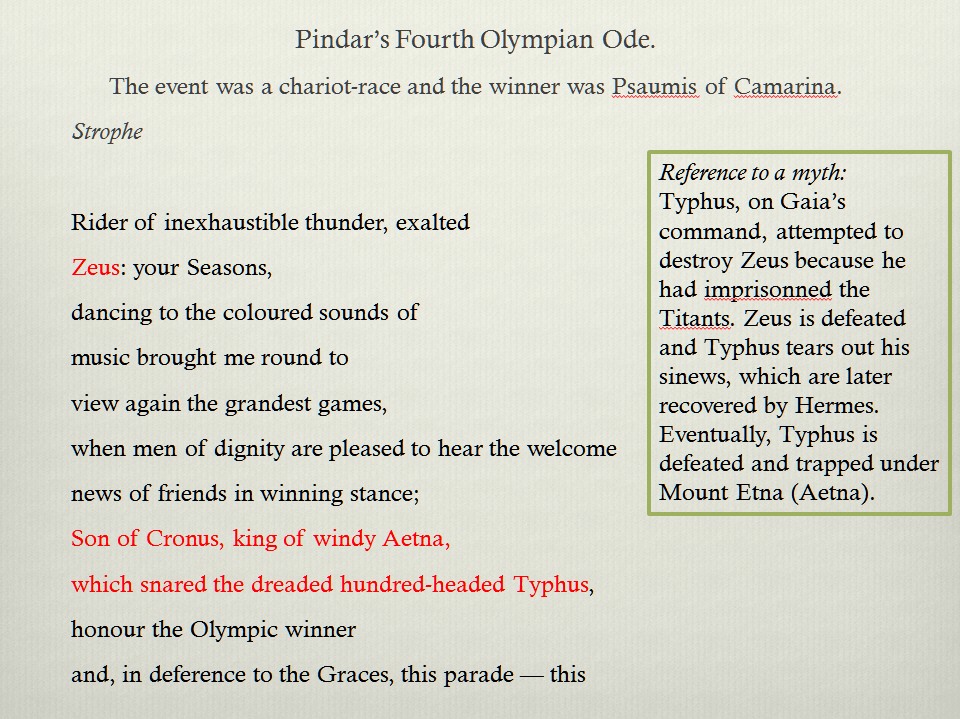
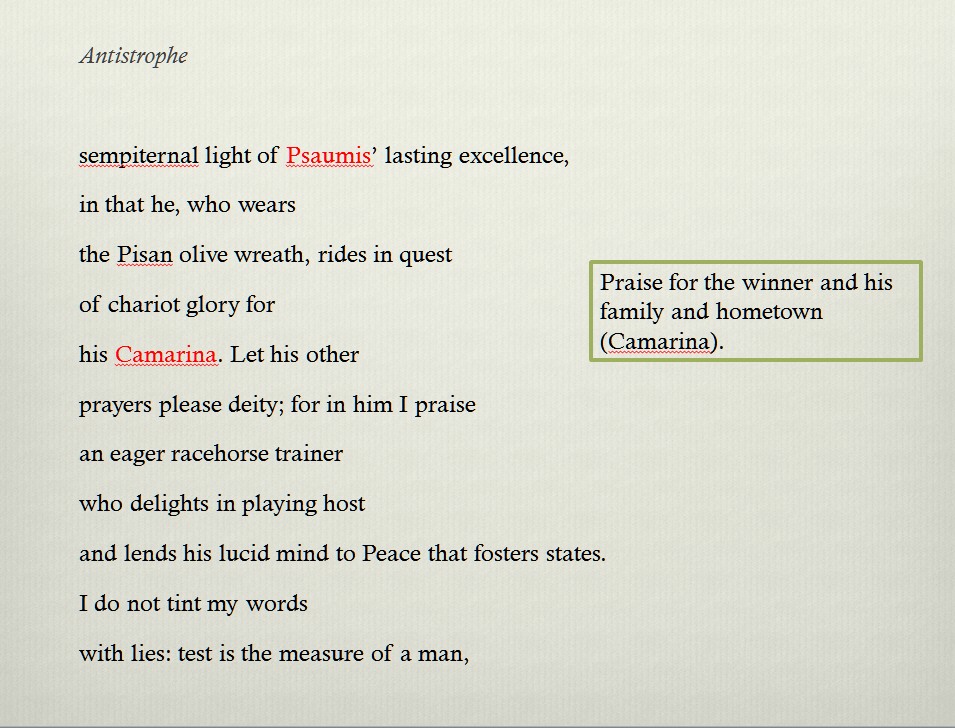
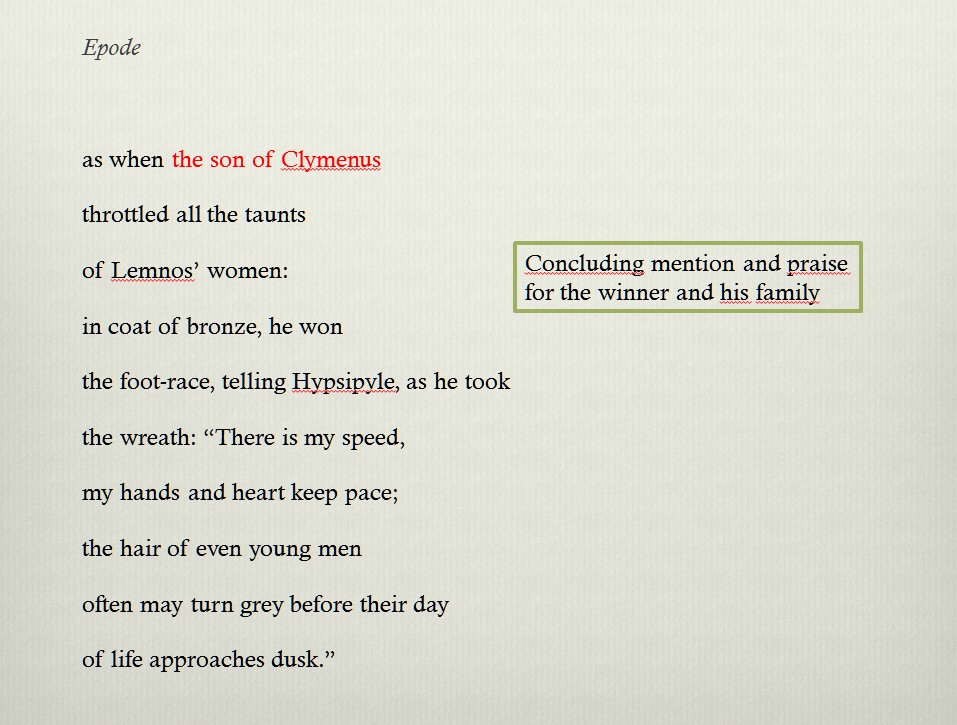
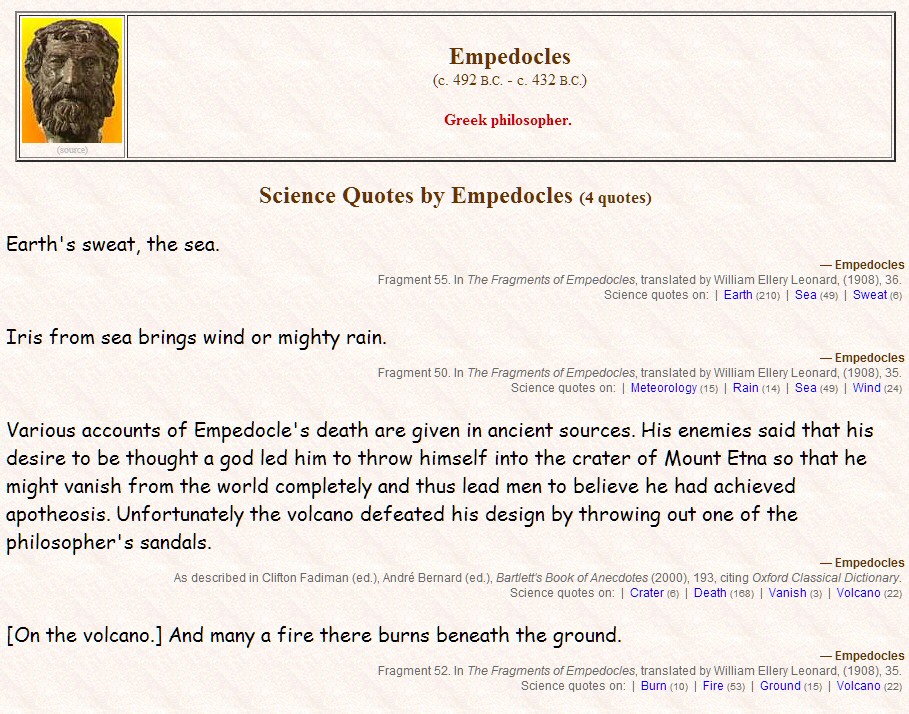
May you not be tortured without ancient precedent,
nor your troubles be less than those of the Trojans,
and may you suffer pain as great as Philoctetes,
heir to Club-bearing Hercules,
from venom’s torment.
Nor let your grief be less than Telephus’,
who drank from
the doe’s teat, and armed received a wound, unarmed help:
or he who fell headlong from his horse in the Aleian field,
Philopoimen, whose character was nearly
his own ruin.
May you know what Phoenix knew,
and, robbed of sight,
find your perilous way with the help of a stick.
Nor see more than Oedipus whom
his daughter guided,
both her parents being acknowledged sinners:
be blind as Tiresias,
the old man famous for Apollo’s
art,
after he’d acted as judge of the gods’ playful quarrel:
and as that man, Phineus,
by whose command a dove of Pallas
was sent out to lead the way, and be a guide to the Argo:
and Polymestor,
lacking eyes, that had viewed gold sinfully,
the father giving them as funeral gifts to his murdered child:
and like Polyphemus, Etna’s
shepherd, whose blinding,
Telemus, son of Eurymus, prophesied
before the event:
like the two sons of Phineus,
from whom he took the same
light he gave: as the faces of Thamyris and Demodocus.
May someone sever your genitals, as Saturn,
when he was born, severed those of Uranus.
Nor let Neptune in
the swelling waves be kinder to you
than to him whose brother and wife were turned into birds,
or to Ulysses,
that cunning man, whom Ino, Semele’s
sister,
pitied as he clung to the shattered timbers of his raft.
Or, lest your flesh shall have known only this one manner
of punishment, let it be split and dragged apart by horses:
or you yourself suffer what the man, who thought to be free
by disgracing Rome, endured from the Carthaginian
leader.
Nor let divine power be prompt to your relief, just as
the altars of Jupiter brought Hercules no
profit.
And as Thessalus leapt
from the heights of Ossa,
you too will throw yourself from the stony cliff.
Or like Cychreus,
who snatched Eurylochus’
crown,
let your body be food for ravenous serpents.
Or, as in Ariadne’s
fate, may raging liquid rush
over your head, covered by the waters.
And like Prometheus,
pinned there, without mercy,
and exposed, feed the birds of the air with your blood.
Or be thrown like stricken Eumolpus,
scion of Erectheus,
three times defeated by mighty Hercules,
into the vast sea.
Or like Phoenix,
child of Amyntor,
the loved will be hated through
shameful desire, and the son wounded by the cruel sword.
Let no more cups be mixed for you that are safe to drink,
than for him who
was born of horned Jupiter.
Or die suspended like the captive Acheus who hung
a wretched witness to the gold-bearing waters.
Or like Achilles’
scion, known by a famous name,
struck down by a tile hurled from an enemy hand.
Nor let your bones lie more happily than Pyrrhus’,
that were scattered over the roads of Ambracia.
Die driven through by javelins like one born
of Pyrrhus: nor may that rite of Ceres hide
you.
And like that king’s scion spoken of just now in my verse,
drink the aphrodisiac juice given you by your parent.
Or be said to have been killed by a sacred adultress,
as Leucon fell
to an avenger said to be holy.
May you send those dearest to you to the pyre,
an ending to his life that Sardanapalus knew.
Like those about
to violate the temple of Libyan Jove,
may the sand driven by south winds bury your face.
Like those killed by the later Darius’s
deceit,
may the ash as it subsides consume your visage.
Or like he who once set out from olive-rich Sicyon,
may hunger and cold be the causes of your death.
Or like the Atarnean may
you be brought, basely,
to your lord as a prize, sewn inside a bull’s-hide.
May your throat be cut in your room, like him
of Pherae,
whose own wife killed him with a sword.
Like Aleuas of Larissa,
by your wound, may you find
those faithless whom you thought were faithful to you.
Like Milo, under whose tyranny Pisa suffered,
may you be hurled alive into shrouded waters.
And may the weapons sent by Jove against Adimantus,
who ruled the Phyllesian kingdom, find you too.
Or like Lenaeus once
from Amastris’s
shores,
may you be left naked on Achillean soil.
And as Eurydamas was drawn three times round
the tomb of Thrasyllus by hostile Larissean wheels,
as Hector who
often rendered the walls safe, circled
them with his body, they not long surviving him,
as the adulterer was dragged over Athenian soil
while Hippomenes’
daughter suffered strange punishment,
so, when that hated life has departed your limbs,
may avenging horses drag your vile body.
May some rock pierce your entrails, as once
the Greeks were pierced in the Euboean Bay:
and as the fierce ravager died by lightning and the waves,
so may the waters that drown you be helped by fire.
May your crazed mind too be driven by frenzies,
like a man who’s whole body is a single wound:
as Dryas’s
son who held the kingdom of Rhodope,
he who was disparately shod on his two feet,
or as Oetean Hercules
was once, Athamas the
serpent’s son-in-law,
Orestes Tisamenus’s
father, and Alcmaeon Callirhoe’s
husband.
May your mother be no more chaste than her whom Tydeus
would have blushed to have as a daughter-in-law:
or the Locrian who, disguised as her murdered
servant, joined in love with her brother-in-law.
And may the gods grant you have such joy in your wife’s
loyalty as Talaus,
or Agamemnon, Tyndareus’s
son-in-law.
or such a wife as the daughters of Belus,
who dared to plan
their cousins’ deaths, whose necks bow, carrying water.
May your sister burn with fire as Byblis and Canace
did, and not prove true except in their sinning.
If you’ve a daughter, may she be what Pelopea was
to Thyestes, Myrrha to
her father, Nyctimene to
hers.
Nor let her be more pious and careful of her father’s life
than yours was Pterelaus,
or yours Nisus,
towards you:
or she who made a place infamous with her crime’s name,
trampling and crushing her father’s limbs under the wheels.
May you die like the young men of Pisa,
whose face
and limbs the mountain slopes outside received:
as Oenomaus who
stained that soil more deeply, himself,
that was often drenched by the blood of wretched princes,
as that cruel tyrant’s traitorous charioteer, Myrtilus,
died, who gave a new name to Myrtoan waters:
as those who sought in vain the speeding girl,
Atalanta, she who was slowed by the
three apples:
those in the hidden cave changed to new monstrous shapes,
never to return from the house of the dark
one:
like those whose bodies violent Aeacides sent
to the high pyre, aged men, and then women:
like those we read of, whom the vile Sphinx killed,
those defeated by the tortuous questions she uttered:
like those sacrificed in Bistonian Minerva’s
temple,
for whom the goddess’s glance is even now hidden:
like those who once were made into a banquet
in the blood-stained stables of Diomede of Thrace:
like those who encountered the lions of Therodamas,
or suffered the Tauric rites
of Thoantean Diana:
like the terrified men that ravening Scylla,
and
opposing Charybdis,
snatched from the Ithacan ship:
like those consumed in Polyphemus’s
vast gut,
like those who fell into Laestrygonian hands:
like those the Punic leader drowned in the waters
of the well, making the depths white with their ashes:
as Penelope’s
twelve handmaids died, and the suitors,
and the chief of the tyrants who armed the suitors:
as the wrestler died, thrown by the Boetian stranger,
his conqueror astonished that he had died:
or the strong men crushed in that Antaeus’s
arms,
or those killed by the savage crowd of Lemnian women:
or the one, denounced for wicked rites, on whom
a stricken victim, at last, brought down vast rains:
like Antaeus’s brother, Busiris,
bound by that blood,
who stained the field, and died by his example:
like the impious man who having poor grass
for fodder, fed his horses on human entrails:
like those two Centaurs, Nessus,
and Eurytion,
son-in-law
of Dexamenus,
killed, with separate wounds, by the same avenger:
like one from his city that your great-grandson,
Saturn, Asclepius,
himself saw restored to life:
like Sinis and Sciron and
his father Procrustes:
and the Minotaur,
half man and half bull:
Sinis, who sent bent pine-trees from earth to air,
to gaze at the Isthmus’ seas on both sides:
and Cercyon,
whom Ceres saw
with delighted
gaze, dying at the hands of Theseus.
Let these ills, and none lighter than these, fall on you,
you whom my anger rightly heaps with curses.
Such as Achaemenides knew,
abandoned on Sicilian
Etna, who saw Aeneas’
Trojan sails approaching:
such a fate as Irus,
too, that beggar with two names, and those
who haunt the bridge: let it be more than you dare hope for.
May you love Plutus,
god of wealth, Ceres’
son, in vain,
and riches fail however you search for them:
and as the ebbing wave retreats in its turn,
and the soft sand washes from under your feet,
so may your fortune always vanish, who knows how,
slipping away, endlessly, flowing through your hands.
And like Erysichthon,
the father of Mestra who
changed her form
repeatedly, may you be wasted by endless hunger though full-fed:
and may you not be averse to human flesh: but in whatever
way you can, may you be the Tydeus of
this age.
And may you commit an
act to make the frantic horses
of the Sun hurtle back from west to east:
may you repeat the vile banquet at a Lycaonian table,
trying to mislead Jupiter with a deceptive food:
and I beg someone to test the power of the god,
serve you as Tantalus’s
son, or the son of Tereus.
And scatter your limbs through the open fields
like the ones that delayed a father’s
pursuit.
May you imitate real bulls in Perillus’s
bronze,
with cries that match the contours of the beast:
like cruel Phalaris,
your tongue first slit with a sword,
may you bellow like an ox in that Paphian metal.
When you wish to return to years of youth, may you
be deceived like Pelias, Admetus’s
old father-in-law.
Or may you be drowned, as you ride, sucked down
by the mud, so long as your name wins no renown.
I want you to die like those born from the serpent’s teeth
that Cadmus,
the Sidonian,
scattered on Theban fields.
Or as Pittheus’s scion’s
did to Medusa’s
cousin,
may ominous imprecations descend on your head:
like one cursed by the birds without warning,
who purifies his body in a shower of water
And may you suffer as many wounds as they say
they suffered, whom a knife used to cut at from beneath.
And, inspired, slash your private parts to Phrygian music,
like those whom Cybele,
the Mother, maddens:
and like Attis,
once a man, become not man or woman,
and strike the harsh cymbals with effeminate hand,
and at a stroke become one of the Great
Mother’s cattle,
turned, in one swift step, from winner to sacrifice.
And lest Limon should suffer his punishment alone,
may a horse with cruel teeth feed on your entrails.
Or like Cassandreus,
no gentler than his master,
be wounded and buried under a pile of earth.
Or like the infant Perseus,
or the Cycnean hero,
may you fall, confined, into the ocean waves.
Or be struck down, a sacrifice to Apollo at
the holy altars,
as Theudotus suffered death from a savage enemy.
Or may Abdera set
you apart for certain days,
and many stones hail down on you, accursed.
Or may you suffer the three-pronged bolts of angry Jove,
like Hipponous’s son, Capaneus,
or Dexithea’s
father,
or Autonoe’s sister, Semele,
or Maia’s
nephew,
like Phaethon who
guided the terrified horses he chose:
like the cruel scion of
Aeolus, and his son of
that blood,
of whom Arctos was
begot, that never knows the water,
or as Macelo and
her husband, struck down by swift flames,
so, I pray, may you die by the fire of the divine avenger.
And may you be their prize to whom is Diana’s Delos,
not before the day Thasos needed to be wasted:
and those who tore apart Actaeon catching
shy
Artemis bathing,
and Linus,
scion of Crotopus.
Nor may you suffer less from a poisonous snake
than Eurydice,
daughter-in-law of Calliope and
old Oeagrus:
than Hypsipyle’s
ward, Opheltes:
than he, of famous horses,
who first fastened a sharp point into hollowed wood.
May you approach high places no more safely than Elpenor,
and suffer the effects of wine in the same way he did.
And die as tamely, as whoever delighted in calling
savage Dryops to
his Theiodamantine weapons:
or as cruel Cacus died,
crushed, in his cave,
given away by the bellowing of oxen inside:
or Lichas who
brought Nessus’
gift steeped in venom,
and stained the Euboean waters
with his blood.
Or like Prometheus may
you hang in Tartarus
from a high rock, or, as books tell, die Socrates’
death:
as Aegeus who
saw the deceptive sail of Theseus’s
ship,
as the child, Astyanax,
thrown from the Trojan citadel,
as Ino,
the nurse, also aunt, of infant Bacchus,
as Talus who
found a saw the cause of his death:
as the envious girl who threw herself from high cliffs,
who had spoken evil words to the unconquered god.
May a brooding lioness of your country, attack you
in your native fields, and be the cause of a death like
Phalaecus’.
May the wild boar that killed Lycurgus’s
son, and Adonis
born of a tree, and brave Idmon,
destroy you too.
And may it even wound you as it dies, like him
on whom the mouth, he had transfixed, closed.
Or may you be like the Phrygian, the Berecyntian hunter,
whom a pine tree killed in the same way.
If your ship touches the Minoan sands,
may the Cretan crowd think you’re from Corfu.
May you be buried in a falling house, like the offspring
of Aleus,
when Jove’s star befriended a scion of Leoprepeus.
Or may you give your name to the flowing waters,
like Evenus or Tiberinus,
drowned in the rushing river.
May you be worthy of truncation, like that son of Astacus,
Melanippus, a maimed corpse, your head
eaten by your fellow men,
or may you give your burning limbs to the kindling pyre,
as they say Broteas did
in his desire for death.
May you suffer death shut in a cave,
like that author of unprofitable stories.
And as fierce iambics harm their creator,
may your insolent tongue be your destruction.
And like him who wounded Athens with
endless
song, die hated through a deficiency of food.
And as it’s said the poet of the grim lyre perished
may a wound to your right hand be the cause of ruin.
And as a serpent wounded Agamemnonian Orestes
may you too die of an envenomed sting.
May the first night of your marriage be the last
of your life: so Eupolis and
his new bride died.
And as they say the tragedian Lycophron ended,
may an arrow pierce you, and cling to your entrails.
Or be torn apart and scattered in the woods by your kin,
as Pentheus at Thebes,
grandson of the serpent, Cadmus.
May you be caught by a raging bull, dragged over wild
mountains, as Lycus’s
imperial wife Dirce was
dragged.
May your severed tongue lie there, before your feet,
as Philomela,
her own sister’s unwilling rival, suffered.
And like dull Myrrha’s
author, Cinna,
harmed by his name,
may you be found scattered about throughout the city.
And may that artisan, the bee, bury his venomous
sting in your eye, as he did to the Achaean poet.
And, on the harsh cliff, may your entrails be torn
like Prometheus,
whose brother’s daughter was Pyrrha.
May you follow Thyestes’
example, like Harpagus’s
son,
and, carved in pieces, enter your father’s gut.
May the cruel sword maim your trunk, and mutilate
the parts, as they say Mamertas’s limbs were maimed.
Or may a noose close the passage of your breath
as the Syracusan poet’s throat was stopped.
Or may your naked entrails be revealed by stripping
your skin, like Marsyas who
named a Phrygian river.
Unhappy, may you see Medusa’s
petrifying face,
that dealt death to many of the Cephenes.
Like Glaucus,
be bitten by the horses of Potniae,
or like the other Glaucus,
leap into the sea’s waves.
Or may Cretan honey choke your windpipe, like one
who had the same name as the two I’ve mentioned.
May you drink anxiously, where Socrates,
wisest of men,
accused by Anytus,
once drank with imperturbable lips.
Nor may you be happier than Haemon in
your love:
or may you possess your sister as Macareus did
his.
Or see what Hector’s
son, Astyanax,
saw from his
native citadel, when all was gripped by flames.
May you pay for infamies in your offspring, as for his
grandfather,
that father’s son,
by whose crime his sister became a mother.
And may that kind of weapon cling to your bones, with which
they say Ulysses,
the son-in-law of Icarius,
was killed.
And as that noisy throat was crushed in the wooden Horse,
so may your vocal passage be closed off with a thumb.
Or like Anaxarchus may you be ground in a deep mortar,
and your bones resound like grain does being pounded.
And may Apollo bury
you in Tartarus’s
depths like Psamathe’s
father, Crotopus,
because of what he did to his son Linus.
And may that plague affect your people, that Coroebus’s
right hand ended, bringing aid to the wretched Argolis.
Like Hippolytus, Aethra’s
grandson, killed by Venus’s
anger,
may you an exile, be dragged away by your terrified horses.
As a host, Polymestor,
killed his foster-child Polydorus,
for
his great wealth, may a host murder you for your scant riches.
And may all your race die with you, as they say
his six brothers died with Damasicthon.
As his funeral added to the musician’s natal ills,
may a just loathing visit your existence.
Like Pelops’
sister, Niobe,
may you be hardened
to standing stone, or Battus harmed
by his own tongue.
If a Spartan boy attacks the empty air with a hurled
discus, may you fall to a blow from that disc.
If any water’s struck by your flailing arms,
may it all be worse to you than the straits of Abydos.
As the comic writer died in the clear waves, while
swimming, may the waters of Styx choke
your mouth.
Or as shipwrecked you ride the stormy sea,
may you die on touching land, like Palinurus.
As Diana’s
guardian did to Euripides,
the tragic poet
may a pack of vigilant dogs tear you to shreds.
Or like a Sicilian may
you leap over the giants’
mouth,
because of whom Etna emits
its wealth of flame.
May the Thracian women,
thinking you Orpheus,
tear your limbs apart with maddened fingers.
As Althaea’s
son burned in the distant flames,
so may your pyre be lit by a burning brand.
As the Colchian bride
was held captive by her new crown,
and the bride’s father, and with the father the household:
as the thinning blood ebbed from Hercules’
body:
so may the baleful venom devour your body.
As his Athenian child avenged Lycurgus may
a wound
be left for you too to receive from a fresh weapon.
Like Milo, may you try to split open the wood with ease,
but be unable to withdraw your captive hand.
May you be hurt like Icarius,
by gifts that an armed
hand brought him from the drunken crowd.
And as a virtuous daughter brought
to death sadly
to her father, may your throat be bound in a noose.
And may you suffer starvation behind your own locked door
like the father who punished himself according to his own law.
May you outrage a phantom, like that of Minerva’s,
who stopped the straits at Aulis being an easy harbour.
Or may you pay by death for a false charge, as Palamedes
was punished, and not delight in what you did not earn.
As Isindius, the host, took the life of Aethalos,
whom even now Ion, mindful, drives from his rites:
as her father himself, from duty, brought Melanthea to light,
when she was hidden in the dark because of murder,
so may your entrails be stabbed by spears,
so, I pray, may all help be withheld from you.
May such night be yours, as Dolon,
the Trojan, who by a coward’s pact, wished to drive the horses, that great Achilles drove.
May you have no quieter a sleep than Rhesus,
and his comrades before him on death’s road:
like those that forceful Nisus son
of Hyrtacus ,and his friend
Euryalus, sent to their deaths with
Rhamnes the Rutulian.
Or like the scion of Clinias, surrounded by dark fires,
may you bear your half-burned bones to a Stygian death.
Or like Remus who
dared to leap the new-made
walls, may a simple spear take your life.
Last, I pray that you may live and die in this place,
between the Sarmatian and
the Getan arrows.
Meanwhile lest you complain that I’ve forgotten you,
these words are sent to you in a hasty work.
It’s brief indeed, I confess: but, by their favour, may the gods
grant more than I ask, and multiply the power of my prayers.
You’ll read more in time, containing your true name,
in that metre in which bitter wars should be waged.
The
End of Ibis
FROM:
http://www.poetryintranslation.com/PITBR/Latin/Ibis.htm

Banquet of the Gods
by Mel Copeland
Book I, Etruscans, Greeks,
Trojans, & Scythians
Table of Contents
Book 1, Etruscans, Greeks, Trojans, &
Scythians, Banquet.html
Book II, Hindus and Celts, Banquet1.html
Book III, Hindus, Banquet2.html
Book IV, Persians and Celts, Banquet3.html
Book V, Trimalchio's Banquet (Of a Roman satire by Petronius), Banquet4.html
Book VI, Divine heroes of Mediterranean myths & the Bible, Banquet5.html
From ancient times
it has been a tradition to celebrate through banquets important events, such
as weddings and funerals. While special feasts were ordered in celebration
of other events and memories, particularly of a society's faith, among the
Indo-Europeans the mourning of a lost chief, king or hero called for a
special event. It appears that twelve days — that
period also being concordant with the 12 months – was the prescribed period
for such events. Here we attempt to understand a peculiar, mysterious
people, the Etruscans, by examining their work and other Indo-Europeans of
the late Bronze Age and early Iron Age (circa. 1,200-850 B.C.) heritage.
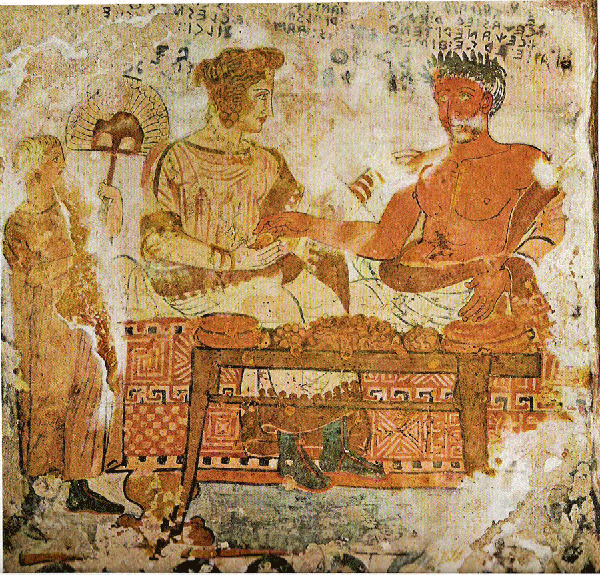 |
Banquet scene in the Tomb of the Shields, Tarquinia
|
Through artifacts,
including murals in tombs, and holy scriptures and other writings, we can learn
to understand what the ancients believed, and also, as in the case of the
Etruscans, we can learn a bit more about their language. Images left behind a
society, whether as a writing or a painting, must be used together to
reconstruct what a society such as the Etruscans may have believed. For
instance, the Etruscans left elaborate tombs carrying grave goods, such as
pottery and replicas of their earthly possessions, and wonderful murals and
paintings on sarcophagi. These in themselves tell us of a society that deeply
believed in an afterlife. A considerable
expense in time and money was proferred by the Etruscans to their departed, whom
we can see in the tombs, were transported to a place that we would today call
heavenly. Today there are societies that still believe that after death their
loved ones are transported to a heavenly place, paradise, as with the
Judao-Christian-Moslem ethic, to be with God. In the days before Christ, the
banquet included a pantheon, many gods. Among the Greeks, for instance, there
were 12 major gods, presided over by a thunder and lightning wielding god, Zeus,
who ruled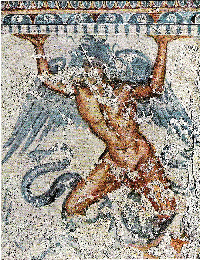 from
the heights of Mt. Olympus. Born from Chronos and Rhea, he and two other gods
made up a triad: Zeus ruled over the heavens, and his brother, Poseidon
earthshaker, ruled over the sea, whilst his other brother, Hades, presided in
the Underworld, the place of the dead, called Erebus. The consort of Zeus was
Hera, daughter of Cronus, a very jealous wife, who had given birth to several
gods, one of whom was, Typhaon or Typhöeus.
Zeus found him to be his worst enemy and ended up throwing the island of Sicily
upon him. Here, in the image from the Tomb of Orcus, we can see Typhöeus, whose
legs are serpents, bracing himself beneath the land. His constant struggle
causes Mt. Etna to roar.
from
the heights of Mt. Olympus. Born from Chronos and Rhea, he and two other gods
made up a triad: Zeus ruled over the heavens, and his brother, Poseidon
earthshaker, ruled over the sea, whilst his other brother, Hades, presided in
the Underworld, the place of the dead, called Erebus. The consort of Zeus was
Hera, daughter of Cronus, a very jealous wife, who had given birth to several
gods, one of whom was, Typhaon or Typhöeus.
Zeus found him to be his worst enemy and ended up throwing the island of Sicily
upon him. Here, in the image from the Tomb of Orcus, we can see Typhöeus, whose
legs are serpents, bracing himself beneath the land. His constant struggle
causes Mt. Etna to roar.
Poseidon's name means
either "husband of the earth: or "lord of the earth," and while he reigned over
the sea and springs, he was known as the cause of earthquakes. Hades, who ruled
in the underworld, abducted Persephone and she was required, by agreement with
Hades, to spend six months of the year in Hades and allowed to spend the other
six months on earth.
The Etruscan pantheon
included Tini (Tinia), who was like Zeus, a sea-god yet unidentified, and
Aita (Hades). Tini, like Zeus, had many wives, but his principal consort was
Uni (Hera). The consort of Atia was Phersipnei (Persephone). The two can be
seen in a mural in the Tomb
of Orcus (another word for
Erebus, the Underworld). The other character in the scene before the throne
of Atia is Ceron (Geryon), a three-headed monster who had a herd of cattle
in Spain. One of Hercules' labors (the 10th) was to steal Geryon's cattle
who ruled the island of Erytheia (now Cadiz). Geryon was later killed at the
river Anthemus (Apollodorus 2.5.10).
Like the Romans w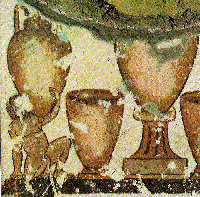 ho
followed them in time, the Etruscans had a pantheon of gods, some of whose names
can be traced to Greek gods. We don't know at this time whether the Etruscans
had a mythological base as rich as that of the Greeks. All we can ascertain at
the moment are the correlations of Etruscan gods to the Greek pantheon and their
associated stories. For instance, in the Tomb of Orcus — a
grim tomb to enter for both the living and the dead, it would appear —the
family that owned the tomb took care to include a mural for the divine
banquet.
ho
followed them in time, the Etruscans had a pantheon of gods, some of whose names
can be traced to Greek gods. We don't know at this time whether the Etruscans
had a mythological base as rich as that of the Greeks. All we can ascertain at
the moment are the correlations of Etruscan gods to the Greek pantheon and their
associated stories. For instance, in the Tomb of Orcus — a
grim tomb to enter for both the living and the dead, it would appear —the
family that owned the tomb took care to include a mural for the divine
banquet.
What happens when one
dies has been something mankind has yet to resolve. It appears, for the most
part, man during the past 30-40,000 years has believed that life after death can
be much as it is on earth. To assure that the departed continue with the
blessings of earth, grave goods were sent with the dead. And these could be
anything from flowers (seen even in Neanderthal graves of 50,000 years ago, as
well as today) to fancy settings including pottery vessels, gold, silver and
bronze articles, clothing, baskets and sacrificial offerings, including cattle,
horses and attendants. In war, in particular, a hero's tomb may include
captives, which we shall see in the description of the burial of Achilles'
friend Patroclos. from the Iliad.
The description from the Iliad of
Patroclus' burial gives us good imagery of what the Greeks and Trojans were
expected to do for their dead heroes. The practice involved at the least pouring
an oblation, usually accompanied by the sacrifice of rams, sheep or cattle on an
altar. A particular god was the recipient of a particular sacrifice.
And if the priests who offered the sacrifice (sometimes the chief or king acted
as the priest) neglected one god in favor of another, then there could be a
disturbance in heaven, sufficient to cause a war among the gods. This happened
to have been, as a matter of fact, a cause of the Trojan War, where one goddess
was slighted over another. In "The Judgment of Paris," a play recording the
episode where Paris (also known as Alexander) was required to judge the most
beautiful goddess of three — Hera,
Aphrodite, and Athena — Aphrodite
was selected. This enraged Hera who swore to take out her wrath against the
Trojans and was joined in the enterprise by Athena. Aphrodite became the mother
of Aeneas, a hero on the Trojan side of the Trojan War. Aphrodite (Greek aphros
= sea foam) was born from the foam raised up by the Genitalia of Uranus, as it
floated near Crete. Uranus was castrated by his son, Cronus. Cronus (called
Saturn by the Romans) was the ruler of the Titans. They were children of Ge
(earth) and Uranus (sky). Cronus deposed his father Uranus by castrating him
with a flint sickle. But he became as tyrannical as his father, and swallowed
all but one of his children by Rhea, his sister and wife. These children were
Hestia, Demeter, Hera, Hades and Poseidon. When Zeus was born Rhea sent the
child to Ge in Crete and fed Cronus a stone wrapped in Zeus' swaddling clothes
instead of Zeus. On reaching maturity Zeus married the Oceanid Metis. She
offered an emetic to Cronus who vomited up his other children. Zeus subsequently
went to war with Cronus and the Titans and threw them all in Tartarus.
One of the first things
we are served in this opening is the fact that the gods fed on one another. They
were bloodthirsty and they had to be appeased. And they loved a good feast just
as men do. Witness Zeus' view of the matter, as he discusses the fate of the
Trojan hero Hector, who was killed by the Greek hero, Achilles:
But when the
twelfth dawn came, Phoebus Apollo said at last: 'You are hard, you gods, you
are torturers! Has not Hector in times past burnt you thigh-pieces of bulls
and goats without blemish? Yet you can't bear to save his dead body for his
wife to see, and his mother and his son, and Priam his father and his
people, to let them burn him in the fire, and perform the rites of
burial...' (1)
Apollo, the son of Zeus
and the Titaness Leto and the brother of Artemis, was born on the island of
Delos. He was worshipped as a shepherd god and god of wisdom and he had an
oracle at Delphi where he had killed a huge snake or dragon. He had taken the
side of the Trojans in the Trojan War and on several occasions managed to save
Hector and others. But the argument over the body of Hector continued. Achilles
dragged Hector's body behind his chariot, around the barrow of Menoitiades for
eleven days, after killing Hector. Zeus closed the argument over Hector's body,
suggesting that Achilles must accept ransom for Hector's body from King Priam:
- 'My dear
Hera, don't go and get spiky with the gods. They shan't be in the same
rank at all, but Hector really was a prime favorite with the gods more
than any man in Troy — at
least, I thought so, for he never failed in his friendly offerings. My
altar was never without a good feast, or libations and spicy savors...' (1)
The old king, Priam,
aided by Hermes, the messenger of the gods, was able to get into Achilles'
compound which was surrounded by a dirt and stake reinforced wall and moat.
Though Priam did not see the body until it had been turned over to him, balmed
and wrapped, Hector's flesh had not decayed. (2)
Achilles gave king
Priam eleven days for the funeral of Hector, and on the twelfth day the Greeks
would resume their attack of the Trojan citadel. Until that time the Trojans
were free to gather what they needed, including large amounts of logs from the
forest atop the mountain, free from fear of Greek attack.
Nine days they gathered with oxen and mules with infinite quantities of wood:
"When the tenth
day dawned, they carried out brave Hector weeping, and laid the body on the
pile and set it on fire.
When on the next day Dawn showed her rosy fingers through the mists, the
people gathered round about the pyre of Hector. First they quenched the
flame with wine wherever the fire had burnt; then his brothers and his
comrades gathered his white bones, with hot tears rolling down their cheeks.
they placed the bones in a golden casket, and wrapt it in soft purple cloth;
they then laid it in a hollow space and built it over with large stones.
Quickly they piled a barrow, with men on the look-out all round in case the
Achaeans should attack before their time. This work done they returned to
the city, and the whole assemblage had a famous feast in the palace of Priam
their King. That was the funeral of Hector."
What was done for
Hector seems to be a good summation of what was probably done for Etruscan
nobles, as seen from their tombs. Because the story says there was limited time
to raise the barrow, the large stones that were placed over the body could not
have been megalithic in size. The barrow follows the description of most barrows
which we can see today. What this ceremony also tells us is that there was no
family barrow, or at least there was not a custom to use a family barrow among
the family of Priam, otherwise Hector's urn or casket would have been placed in
an existing barrow or tumulus. In Britain and Ireland barrows were often used
over again and urns can be found on the perimeter of a barrow. Such tumuli can
be see on www
stone pages. We can compare this rite to the one given to Patroclus. These
rites we can compare to the rites of the Aryans in the Indus Valley.
While tumuli or dolmens can be traced from Britain to Korea, where they appear
in India is not where the traditional Aryan homeland of India is (the
traditional area being the Punjab and Indus River valley). Interestingly, the
earliest Hindu documents, the Rig Veda, describe an area in the northwest of
India and Pakistan, whereas the megaliths of India are found in the south of
India, among the brown-skinned Dravidians.
The Rig Veda records
five tribes of Indo-Europeans whose primary concern was cattle-raids, gaining
wealth through warfare against the brown-skinned natives. As we progress through
the ten books of the Rig Veda we
find ourselves dealing with a people whose concerns have transformed from those
who were trying to lodge a place in the land to a people who were fighting not
only their ancient enemies but also each other. Is it possible that in the
episode the original pastoral Aryans were forced into the South of India where
they left the Indo-European-like megalithic monuments? Following the Rig
Veda in antiquity, and placing
the foundations of the gods in the Rig
Veda into sacred prose is the Mahabharata.
This book bends towards a memory of a people who are definitely Iron Age and the
Pandava heroes in the story are brown-skinned, but their gods, like Indra, tend
to be fair-skinned — Indra,
a god that throws lightning bolts, has yellow hair.
The god Shiva is hardly mentioned in the Rig
Veda and becomes more prominent
in the Mahabharata. There the
god Shiva is often greeted in the forest, seen as an old man of the forest. This
a early view of Shiva being connected to the animals of the forest that is
common to the view of the Celtic god Cernunnos (Greek spelling, karnonou,
from the Montagnac inscription recorded in Dictionnaire
de la langue gauloise by Xavier
Delamarre), who is depicted with stag horns coming out of his head and
accompanied by a ram-headed serpent and a stag. He is pictured in the center of
a Gallo-Roman altar from Reims, as well as the Gundestrup cauldron.
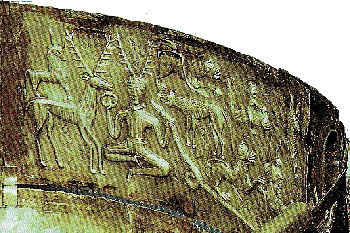 |
|
Image of the
Celtic god Cernunnos on the Gundestrup cauldron
|
On either side of him in the
Gallo-Roman altar from Reims are two gods. On his right is a god with a harp
(Apollo) and the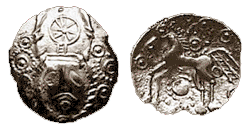 god
on his left is believed to be Mercury. On the Gundestrop cauldron the Celtic god
is holding in his right hand a torque, wears one around his neck, and in his
left hand he holds a ram-headed serpent, also a symbol of the sun-god.
god
on his left is believed to be Mercury. On the Gundestrop cauldron the Celtic god
is holding in his right hand a torque, wears one around his neck, and in his
left hand he holds a ram-headed serpent, also a symbol of the sun-god.
To view Celtic coins go
to http://www.kernunnos.com or
click on the coins above. The extensive coin collection, which can be reviewed
by clicking on a map, includes an image of the Horned God. Between his horns is
a wheel, a sign of the sun-god. "The
Celtic Horned God is born at the winter solstice, marries the goddess Beltane,
and dies at the summer solstice. He alternates with the goddess of the moon in
ruling over life and death, continuing the cycle of death, rebirth and
reincarnation,"sayshttp://www.pantheon.org/articles/c/cernunnos.html.
The Horned God of
the Celts is nearly identical to the Mahabharata picture
of Shiva and is also like images on the Indus Valley (Harappa) seals. To view
more seals and follow the progress of the Indus Valley archaeology go to: http://www.harappa.com/.
To read the Rig Veda and
associated documents go to:http://www.sacred-texts.com/hin/.
The Indus Valley
Seals:
|
|
|
|
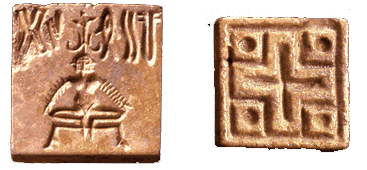 |
|
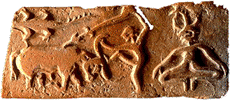 |
|
|
|
|
|
The Indus Valley
seals — about
400 of them have been found —carry
inscriptions which have not been translated and date to about 1,800-1,500
B.C. Note
how the Indus character here represented has two faces, like the Latin
Janus. He is identified, like the Phoenician Melqart, with a bull. The
sacrifices to the sun-god Melqart involved human sacrifice, which was also a
practice of the Celts in their sacrifice to Curnunnos. We know that in the Iliad part
of the memorial feast at the burial of a hero, 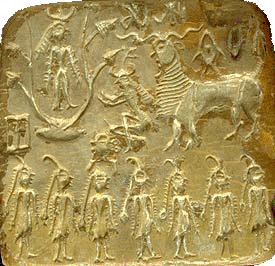 such
as Patroclos (Patroclus), involved the sacrifice of captives. While the
Celtic sacrifice is connected with the seasons, rebirth, the sacrifice of
the Trojan captives in the Iliadmay
not have involved such. However, the sacrifice and burial ceremony took
place at dawn.
such
as Patroclos (Patroclus), involved the sacrifice of captives. While the
Celtic sacrifice is connected with the seasons, rebirth, the sacrifice of
the Trojan captives in the Iliadmay
not have involved such. However, the sacrifice and burial ceremony took
place at dawn.
In the burial of
Patroclos animals are sacrificed and care is taken to make sure that the
bodies of the victims were placed away from the bier of the hero which was
in the center of the pyre. Instructions are given to put them along the edge
of the sacrificial ring. Important to the sacrifice was the offering of a
bull. This can be seen in the Indus Valley seal above and it was a practice
of the megalith builders of Ireland and Britain. The evidence of Bull
sacrifice is at Stonehenge, for
instance. Megalithic monuments, including tumuli, were oriented with respect
to the solstice and no doubt there were ceremonies conducted at dawn,
probably also at dusk. The rite at dusk among the Celts and Germans involved
at least the god Odin (Woden, after whom the day, Wednesday, is named), who
is known for human sacrifice and his wild hunts on the full moon. Beheading
was the common method of sacrificing humans, and the Celts had a reputation
for riding into war and cattle-raids with the heads of those whom they
conquered hanging from their horses. Hanging was another form of sacrifice
and punishment. Odin was believed to pass by the hanging corpses of the dead
during the evening. Odin has an interesting history, since the Norse
tradition, which perhaps has given us the most complete memory on Odin,
records that he and his people were originally located in Asia Minor, near
the Black Sea. To read the story, called the The
Ynglinga Saga, go to:http://sunsite.berkeley.edu/OMACL/Heimskringla/.
According to Herodotus the Celts were "the most westerly of all the nations
of Europe, excepting the Cynetians" (Herodotus, Book IV, http://classics.mit.edu/Herodotus/history.4.iv.html.
Greek and Trojan
Burial Rite
When we examine
paintings and images on artifacts, such vases, sarcophagi or the walls of
tombs, we need to keep in mind that the images tell a story, and to
understand the story being told we need to read the inscriptions with them,
if they exist, and compare the images to written and drawn images of which
we know. We should also keep in mind that funerals of heroes were great
social events — no
less so than a modern day funeral of a soldier fallen in the (currently
on-going, as of 8.22.04) Second War of Iraq. When we watch funeral
processions in the streets of Iraq, where the dead are carried in caskets
above the shoulders behind a multitude of shouting and furious mourners, we
can see at least in part the reaction that Achilles and his comrades held
when they buried their hero and friend Patroclos. So let's get to it, with
reference to the Iliad,
translated by W. H. D. Rouse:
Iliad,
Book XVI, p. 201, 202: When Hector [the Trojan hero] saw him retreating
and wounded, he came near and stabbed him in the belly: the blade ran
through, he fell with a dull thud, and consternation took the Achaeans.
So fell Patroclos, like a wild boar killed by a lion, when both are
angry and both are parched with thirst, and they fight over a little
mountain pool, until the lion is too strong for the panting boar.
Patroclos Menoitadês had killed many men, but Hector Priamidês killed
him: and then he vaunted his victory without disguise:
"So Patroclos, you thought that you could sack our city! You thought you
would rob our women of the day of freedom, and carry them off to your
own country! Fool! In front of them are the horses of Hector prancing
out to battle. My spear is well known among my brave Trojans, for I
defend them from the day of fate: here you shall stay and feed the
vultures! Ah, poor wretch, your Achillês is a good man, but he was no
help to you, although no doubt he warned you earnestly when you started
(and he stayed behind) — 'Don't
come back to me, my brave Patroclos, until you have stript the
blood-stained shirt from Hector's body!' No doubt he must have said
that, and you thought you could do it — no
more sense in you than that!"
Patroclos replied, half fainting:
"For this once, Hector, make your proud boast; for you are the victor,
by help of Zeus Cronidês and Apollo, who mastered me – an easy thing:
they stript off my armor themselves. But if twenty men like you had
confronted me, my spear would have slain them all on the spot. No, it
was cruel fate that killed me, and Leto's son, and of men Euphorbos; you
come third and take my armor. One thing I tell you, and you should lay
it up in your mind: you have yourself not long to live. already death
and fate are beside you, and Achillês Aiacidês shall lay you low."
Even as he spoke, the shadow of death covered him up. His soul left the
body and went down to Hadês, bewailing his lot, cut off in his manhood
and strength. But Hector answered him though dead:
"What is
the prophecy of certain death to me, Patroclos? Achillês may be the son
of the divine Thetis, but who knows if I may not strike him with my
spear, and he may be the first to die!"
Then he set one foot upon the body, and treading it away from the spear,
pulled out the spear, and went at once with the spear after the driver
Automedon. He wanted to kill him too, but the immortal horses which the
gods had given to Peleus were carrying him out of the way.
Iliad,
Book XXII, pp. 262, 263 [Achillês, having just killed Hector] Hector
answered him dying: "Ah, I know you well, and I forebode what will
be...As he spoke, the shadow of death encompassed him; and his soul left
the body and went down to Hadês, bewailing his fate, bidding a last
farewell to manhood and lusty strength. Hector was dead, but even so
Achillês again spoke:
"Lie there
dead! My fate I will accept, whenever it is the will of Zeus and all
gods to fulfil it."
He drew
the spear out of the body and laid it aside. Then he stript off the
armor, and the other Achaeans came crowding round. How they gazed in
wonder at Hector's noble form and looks! Yet no one came near without a
stab; they beat him and stabbed him, saying to each other: "Ha, ha!
Hector feels very much softer now than when he burnt our ships with his
blazing brands!"
Achillês, when he finished stripping the spoils, turned to the crowd,
and made them a speech in his downright manner: "My friends, " he said,
"princes and captains of the nation, since as you see the gods have
granted me to kill this man who has done us more damage than all the
rest put together, let us go round the city ready for battle, and find
out what they mean to do: whether they will leave their fortress now
that this man is dead, or whether they will still confront us although
they have no Hector. — But
stay, what am I thinking about! Patroclos lies beside our ship
unmourned, unburied! Patroclos I can never forget so long as I live and
move! And even if in the house of Hadês men forget their dead, yet I
will remember my dear comrade even there. Come on, my lads, let us march
back to our ships singing our hymn of victory, and bring this man with
us. We have won a great triumph; we have killed Hector, to whom the
Trojans prayed as if he were a god!"
And then he thought of a shameful outrage. He cut behind the sinews of
both hector's feet from ankle to heel and strapt them together with
leather thongs, and fastened them to his chariot leaving the head to
drag. Then he laid the armor in the car, and got in himself and whipt up
the horses. Away they flew: the dust rose as the body was dragged along,
the dark hair spread abroad, there in the dirt trailed the head that was
once so charming, which now Zeus gave to his enemies to maltreat in his
own native land. And as the head was bedabbed thus in the mire, his
mother tore her hair and threw away the covering veil, and wailed aloud
seeing her son; his father lamented sore, the people wailed, and
lamentation filled the city. Such lamentation there might have been, if
all frowning Ilios were smouldering in ashes.
Iliad,
Book XXIII, pp265-281. While the Trojans were mourning within their
city, the Achaeans made their way to the ships beside the Hellespont.
Most of them dispersed to their own vessels, but Achillês would not let
the Myrmidons disperse until he had addressed them in these words:
"Your horses have done good service today, my brave comrades; but we
must not unyoke them yet. Let us go, horses and chariots and all, to
mourn for Patroclos, for that is the honour due to the dead. When we
have consoled ourselves with lamentation, let us unharness them and take
our meal."
Then he led the cavalcade three times round the body, all mourning and
crying aloud; and Thetis lamented with them. The sands were drenched, so
much their hearts longed for that mighty man. And Peleidês led their
lamentations, as he laid his manslaying hands on his true friend's
breast:
"Fare thee well, Patroclos, even in the house of death! See now I am
fulfilling all that I promised! I said I would drag Hector to this place
and give him to the dogs to devour raw; and in front of your pyre I
would cut the throats of twelve noble sons of the Trojans, in payment
for your death."
Then he did a vile outrage to royal Hector; he stretched the body on its
face in the dirt beside the bier of Menoitadês.
After that all took off their armor, and unharnessed the loud-whinnying
horses, and sat down beside the ship of Achillês in their thousands.
There he provided a fine funeral feast. Many bellowing bulls fell under
the knife, many sheep and bleating goats; many tusker boars bursting
with fat were stretched out to singe over the fire. Around the dead body
the blood of the victims poured out in cupfuls was running all over the
ground.
Meanwhile Prince Peleion was being led by the Achaean chieftains to
Agamemnon. They had trouble to persuade him, so deep was his sorrow for
his comrade. At the King's headquarters orders were given to set a
cauldron of water over the fire, that his body might be washed clean of
the bloodstains, but he flatly refused and swore to it:
"No, by Zeus highest and greatest of gods! It is not lawful that water
may come near my head, before I lay Patroclos on the fire and build him
a barrow and cut off my hair! For no second sorrow like this shall come
upon me so long as I am among the living. Yet, for this present we must
consent to the meal which we hate. Then tomorrow, my lord King
Agamemnon, shall be for bringing firewood and providing all that is
proper to send the dead down into the dark. The fire shall burn him
quickly out of sight, and the people shall return to their work."
[They did accordingly and Patroclos appears to Achillês in a dream that
evening] ..."You sleep, Achillês, and you have forgotten me! When I
lived you were not careless of me, but now that I am dead! Bury me
without delay, that I may pass the gates of Hadês. Those phantoms hold
me off, the souls of those whose work is done; they will not suffer me
to join them beyond the river, but I wander aimlessly about the broad
gates of the house of Hadês. And give me that hand, I pray; for never
again shall I come back from Hadês when once you have given me my
portion of fire...do not lay my bones apart from yours, Achillês, but
with them, as I was brought up with you in your home...Then let one urn
cover my bones with yours, that golden two-handled urn which your
gracious mother gave you."
...They were still mourning when Dawn showed her fingers of light. Then
King Agamemnon sent out mules and men from the whole camp to bring
firewood..On the foothills of Mount Ida they felled the tall trees
busily...Down on the shore they laid their logs in order, in the place
where Achillês designed a great barrow for Patroclos and himself.
When the logs were laid in their places, the men sat where they were,
all together. Then Achillês ordered his Myrmidons to don their armor and
harness their horses; they mounted the cars, fighting men and drivers,
chariots in front, a cloud of footmen behind, thousands, and in the
midst was Patroclos borne by his comrades. They had cut off their hair
and thrown it over the body like a shroud. Achillês came behind him
clasping the head; his own unspotted comrade he was escorting to the
grave.
At the place which Achilles had appointed, they laid him down and piled
great heaps of firewood. Then Achillês did his part. He stood away from
the pile, and cut off the golden tress which he had kept uncut among his
thick hair for the river Spercheios, and spoke deeply moved as he gazed
over the dark sea:
"O Spercheios! This is not for thee! That vow was vain which Peleus my
father made, that when I returned to my native land I would consecrate
my hair to thee, and make solemn sacrifice, and that he would sacrifice
fifty rams without blemish into thy waters, at the altar which is in thy
precinct at the same place. (2)
..Now
therefore, since I am not to return to my native land, I wold give the
warrior Patroclos this to carry with him."
Then he laid the hair in the hands of his well-beloved companion. All
present broke into lamentation with all their hearts; and they would not
have ceased while the sun shone, but Achillês drew near to Agamemnon and
said to him:
"Atreidês, you are our lord paramount, and it is yours to command. There
is plenty of time for the people to mourn, but just now I ask you to
dismiss them from this place and tell them to get ready their meal. All
this is the business of those who are nearest akin to the dead; and let
the chieftains remain with us."
Agamemnon accordingly dismissed the people, while the mourners remained,
and piled up the wood, and made a pyre of a hundred feet each way, and
upon it they laid the body. They killed flocks of sheep and herds of
cattle in front of the pyre, skinned them and cut them up; Achillês took
away all the fat, and covered the dead with it from head to foot, and
heaped the flayed bodies about him. Jars of honey and oil he placed
leaning against the bier. Four horses he laid carefully on the pyre,
groaning aloud. Nine dogs the prince had, that fed from his table; two
of these Achillês took, and cut their throats and laid beside him, The
twelve noble young Trojans he slew without mercy. Then he applied the
relentless fire to consume all, and with a groan he called on his
comrade's name:
"Fare thee well Patroclos, even in the grave fare thee well! See, I now
fulfil all that I promised you before. Here are the twelve noble sons of
Trojans — the
fire is eating them round about you! Hector Priamidês the fire shall not
have to eat, but the dogs!"
But his threat was in vain: no dogs were busy about Hector, for the dogs
were driven off by the daughter of Zeus, Aphroditê herself, by day and
by night. She washed the skin with rose-oil of ambrosia that it might
not be torn by the dragging; and Phoebus Apollo drew down a dark cloud
from heaven to earth, and covered the place where the body lay, that the
sun might not scorch the flesh too soon over the sinews of his limbs.
But the pyre would not burn, and Achillês did not know what to do. At
last he stood well away from the smouldering heap, and prayed to North
Wind and West Wind promising them good sacrifices; many a libation he
poured from his golden goblet, praying them to come and make the wood
quickly catch fire, to burn the bodies. (3)
Iris heard his prayers, and flew quickly to the Winds with her
message...Her message given, away she flew, and the Winds rose with a
devil of a noise and drove the clouds in a riot before them. They
swooped upon the sea and raised the billows under their whistling
blasts; they reached the Trojan coast and fell on the pyre till the
flames roared again. All night long they beat upon the fire together
blowing and whistling; all night long stood Achillês holding his goblet,
and dipt into the golden mixer, (3) and
poured the wine on the ground, till the place was soaked, calling upon
the soul of unhappy Patroclos. As a father laments while he burns the
bones of his son, newly wedded and now dead, to the grief of his
bereaved parents, so Achillês lamented as he burnt the bones of
Patroclos, stumbling up and down beside the pyre with sobbings and
groanings. But at the time when the morning star goes forth to tell that
light is coming over the earth, and after him the saffron mantle of Dawn
spreads over the sea, at that hour the flame died down and the burning
faded away. Then the Winds returned over the Thracian gulf to their
home, while the waters rose and roared.
And then Achillês moved away from the pyre, and sank upon the ground
tired out; sleep leapt upon him and gave him peace.
Now the people were all gathering round Agamemnon. They made such noise
and uproar that Achillês sat up and said:
"Atreidês, and you other princes, you must first quench the pyre with
wine wherever the flames have touched. Then let us gather the bones of
Patroclos Menoitidês, and be careful to find the right ones. They are
easy to know, for he lay right in the middle and the others were on the
edge, horses and men together. His bones we must wrap in a double layer
of fat and lay them in a golden urn, until I myself shall be hidden in
Hadês. But I do not wish any great mound to be raised for him, only just
a decent one. Afterwards another can be raised both broad and high, by
those of you who are left behind me."
They did his bidding at once. First they quenched the pyre with wine
wherever it had burnt and the ashes were deep; then weeping they
gathered the bones of their gentle companion, and laid them covered with
fat in a golden urn, which they wrapt up in fine linen and put away
safely in the hut. (4) Round
the pyre they set up a circle of stone slabs to mark the outside limit,
and shovelled earth within.
As they were about to go after finishing this task, Achillês told them
to stop, and made them sit in a ring while he sent back for prizes:
cauldrons and tripods, horses and mules and fine cattle, women also and
grey steel. (5)
The next step in
the burial ceremony is the conduct of games, in competition for the prizes
offered by the host (Achillês). Many of these prizes represent items found
in tumuli, from among the Scythians to the British. The Etruscans not only
painted these games in their tombs, many items of the games and everyday
things were carved on the walls of the tombs. A view of the games venerated
in the Iliad can be seen through the Etruscan tombs. To view the murals
click here:Etruscan_Murals.html.
We abbreviate the games conducted by Achillês:
For the
chariot-race he offered as first prize a woman skilled in women's work,
and a tripod of two-and-twenty measures with handles to it. The second
prize was a mare..The third was a cauldron of four measures, brand-new
and still white. The fourth, two ingots of gold, and the fifth a
breand-new basin with handles...[on how to win the chariot-race] "And
the tricks of the trade make driver beat driver. One man leaves
everything to horses and car, wheels wide to this side or that side
carelessly, the horses go roaming over the course, he does not hold them
in hand; but he that knows his tricks may have inferior horses to drive — yet
he keeps his eye always on the post, wheels close in, does not forget
how much to stretch the horses at first by the handling of the reins,
but keeps them well in hand and watches the man in front.
"Now I will tell you the mark — you
can't miss it. There's a dry stump at the turn of the road standing
about a fathom above the soil, oak or fir, which does not rot in the
rain. Two white stones are set against it, one on each side, and the
land round this is smooth for horses. It may be the mark of some man
dead long ago, or set up for a post in former days, and now Achillês has
fixed it for the turning-point of his race. (6)...[a description of one
of the chariots] and the car with its gold and tin plates gleaming
rolled behind: the tires left hardly a trace in the light dust, so
quickly they flew.
...Next he displayed the prizes for boxing. a hard battle that is! And
the prize was a much-enduring mule, a six-year-old yet unbroken, the
hardest age to break. The prize for the loser was a two handled
goblet...Euryalos rose alone, a splendid fellow..Tydeidês got him ready.
He put on his belt, gave him the gloves of good oxhide straps, cheered
him up, and wished him luck.
...Without delay Peleidês displayed the third set of prizes, for the
wrestling — and
a hard bout that is! He showed the prizes all round. For the winner, a
large tripod to stand on the fire, which the spectators valued at twelve
oxen. For the loser, he brought out a woman well skilled in women's
work, valued at four oxen...
Achillês now brought out prizes for the footrace. There was a silver
mixing-bowl finely wrought, holding six measures. It was the most
beautiful bowl in the world, for it was the work of Sidonian artists,
and Phoenician merchants had brought it over the sea to the harbour of
Lemnos and given it to Thoas as a gift; his grandson Euneos Isasonidês
gave it to Patroclos as the price of Lycaon. This bowl Achillês offered
as first prize, for the second a great fat ox, and for the last a
half-nugget of gold. (7)
...Now Achillês brought out the armor of Sarpedon which Patroclos had
taken in the field — the
long spear and the shield and helmet, and said:
"We invite the two best men to contend for these. Let them arm
themselves and take their blades, and try one another before us.
Whichever shall first pierce through the armor to what is within and
touch the flesh and draw blood, to him I will give this fine Thracian
sword silver-bossed which I took from Asteropaios, but the armor both
shall hold together; and we will make a good feast to entertain them."
...Again Achillês brought out a lump of roughcast iron which that mighty
man Eëtion used to hurl. When he killed Eëtion, he brought it away with
the rest of the spoils. He rose now and said:
"Rise you who wish to contend for this prize. Any man will have enough
here to use for five revolving years, even if his fat fields are far
away. No shepherd or plowman will need to visit the city for iron, there
will be plenty at home." ...and Epeios took up the weight, circled it
round his head and put it, and the people roared with laughter. Next to
put the weight was Leonteus, that veritable sprig of Arês; third
Telamonian Aias lifted it and hurled it. The cast from that strong man
went beyond the others. But when Polypoitês raised the lump, he threw it
as far beyond all the others as a herdsman sends his cudgel flying over
the herds of cattle. (6)
..Next
for the archers Achillês brought forward blue steel — ten
axes and ten half-axes...Again Peleidês brought out a long spear, and a
brand-new cauldron ornamented with flowers, worth one ox..
By the time of
Herodotus (~484-420 B.C.), of Halicarnassus, Asia Minor (now Bodrum,
Turkey), the citadel of Troy was "insignificant." Click here http://classics.mit.edu/Herodotus/history.1.i.html to
read his view, as a historian of his time under Persian dominion at
Halicarnassus. Here you can read his view of the history of Lydia. In
Book II (link below) Herodotus points out that the Pelasgians who
occupied Greece before the Greeks had not assigned names to their gods.
Homer and Hesiod, who lived 400 years before his time: "For Homer and
Hesiod were the first to compose Theogonies, and give the gods their
epithets, to allot them their several offices and occupations, and
describe their forms; and they lived but four hundred years before my
time, as I believe."
Egyptian
Sacrifices, according to Herodotus (from
http://classics.mit.edu/Herodotus/history.2.ii.html)
Male kine are
reckoned to belong to Epaphus, and are therefore tested in the following
manner:- One of the priests appointed for the purpose searches to see if
there is a single black hair on the whole body, since in that case the
beast is unclean. He examines him all over, standing on his legs, and
again laid upon his back; after which he takes the tongue out of his
mouth, to see if it be clean in respect of the prescribed marks (what
they are I will mention elsewhere); he also inspects the hairs of the
tail, to observe if they grow naturally. If the animal is pronounced
clean in all these various points, the priest marks him by twisting a
piece of papyrus round his horns, and attaching thereto some
sealing-clay, which he then stamps with his own signet-ring. After this
the beast is led away; and it is forbidden, under the penalty of death,
to sacrifice an animal which has not been marked in this way.
The following is their manner of sacrifice:- They lead the victim,
marked with their signet, to the altar where they are about to offer it,
and setting the wood alight, pour a libation of wine upon the altar in
front of the victim, and at the same time invoke the god. Then they slay
the animal, and cutting off his head, proceed to flay the body. Next
they take the head, and heaping imprecations on it, if there is a
market-place and a body of Greek traders in the city, they carry it
there and sell it instantly; if, however, there are no Greeks among
them, they throw the head into the river. The imprecation is to this
effect:- They pray that if any evil is impending either over those who
sacrifice, or over universal Egypt, it may be made to fall upon that
head. These practices, the imprecations upon the heads, and the
libations of wine, prevail all over Egypt, and extend to victims of all
sorts; and hence the Egyptians will never eat the head of any animal.
The disembowelling and burning are, however, different in different
sacrifices. I will mention the mode in use with respect to the goddess
whom they regard as the greatest, and honour with the chiefest festival.
When they have flayed their steer they pray, and when their prayer is
ended they take the paunch of the animal out entire, leaving the
intestines and the fat inside the body; they then cut off the legs, the
ends of the loins, the shoulders, and the neck; and having so done, they
fill the body of the steer with clean bread, honey, raisins, figs,
frankincense, myrrh, and other aromatics. Thus filled, they burn the
body, pouring over it great quantities of oil. Before offering the
sacrifice they fast, and while the bodies of the victims are being
consumed they beat themselves. Afterwards, when they have concluded this
part of the ceremony, they have the other parts of the victim served up
to them for a repast.
The male kine, therefore, if clean, and the male calves, are used for
sacrifice by the Egyptians universally; but the females they are not
allowed to sacrifice, since they are sacred to Isis. The statue of this
goddess has the form of a woman but with horns like a cow, resembling
thus the Greek representations of Io; and the Egyptians, one and all,
venerate cows much more highly than any other animal. This is the reason
why no native of Egypt, whether man or woman, will give a Greek a kiss,
or use the knife of a Greek, or his spit, or his cauldron, or taste the
flesh of an ox, known to be pure, if it has been cut with a Greek knife.
When kine die, the following is the manner of their sepulture:- The
females are thrown into the river; the males are buried in the suburbs
of the towns, with one or both of their horns appearing above the
surface of the ground to mark the place. When the bodies are decayed, a
boat comes, at an appointed time, from the island called Prosopitis,-
which is a portion of the Delta, nine schoenes in circumference,- and
calls at the several cities in turn to collect the bones of the oxen.
Prosopitis is a district containing several cities; the name of that
from which the boats come is Atarbechis. Venus has a temple there of
much sanctity. Great numbers of men go forth from this city and proceed
to the other towns, where they dig up the bones, which they take away
with them and bury together in one place. The same practice prevails
with respect to the interment of all other cattle- the law so
determining; they do not slaughter any of them.
Such Egyptians as possess a temple of the Theban Jove, or live in the
Thebaic canton, offer no sheep in sacrifice, but only goats; for the
Egyptians do not all worship the same gods, excepting Isis and Osiris,
the latter of whom they say is the Grecian Bacchus. Those, on the
contrary, who possess a temple dedicated to Mendes, or belong to the
Mendesian canton, abstain from offering goats, and sacrifice sheep
instead. The Thebans, and such as imitate them in their practice, give
the following account of the origin of the custom:- "Hercules," they
say, "wished of all things to see Jove, but Jove did not choose to be
seen of him. At length, when Hercules persisted, Jove hit on a device-
to flay a ram, and, cutting off his head, hold the head before him, and
cover himself with the fleece. In this guise he showed himself to
Hercules." Therefore the Egyptians give their statues of Jupiter the
face of a ram: and from them the practice has passed to the Ammonians,
who are a joint colony of Egyptians and Ethiopians, speaking a language
between the two; hence also, in my opinion, the latter people took their
name of Ammonians, since the Egyptian name for Jupiter is Amun. Such,
then, is the reason why the Thebans do not sacrifice rams, but consider
them sacred animals. Upon one day in the year, however, at the festival
of Jupiter, they slay a single ram, and stripping off the fleece, cover
with it the statue of that god, as he once covered himself, and then
bring up to the statue of Jove an image of Hercules. When this has been
done, the whole assembly beat their breasts in mourning for the ram, and
afterwards bury him in a holy sepulchre.
...The Egyptians were also the first to introduce solemn assemblies,
processions, and litanies to the gods; of all which the Greeks were
taught the use by them. It seems to me a sufficient proof of this that
in Egypt these practices have been established from remote antiquity,
while in Greece they are only recently known...Besides this form of
divination [referring to the Dodonaean, women oracles who sounded like
doves] the Greeks learnt also divination by means of victims from the
Egyptians.
The Egyptians were also the first to introduce solemn assemblies,
processions, and litanies to the gods; of all which the Greeks were
taught the use by them. It seems to me a sufficient proof of this that
in Egypt these practices have been established from remote antiquity,
while in Greece they are only recently known.
The Egyptians do not hold a single solemn assembly, but several in the
course of the year. Of these the chief, which is better attended than
any other, is held at the city of Bubastis in honour of Diana. The next
in importance is that which takes place at Busiris, a city situated in
the very middle of the Delta; it is in honour of Isis, who is called in
the Greek tongue Demiter (Ceres). There is a third great festival in
Sais to Minerva, a fourth in Heliopolis to the Sun, a fifth in Buto to
Latona, and a sixth in Papremis to Mars.
The following are the proceedings on occasion of the assembly at
Bubastis:- Men and women come sailing all together, vast numbers in each
boat, many of the women with castanets, which they strike, while some of
the men pipe during the whole time of the voyage; the remainder of the
voyagers, male and female, sing the while, and make a clapping with
their hands. When they arrive opposite any of the towns upon the banks
of the stream, they approach the shore, and, while some of the women
continue to play and sing, others call aloud to the females of the place
and load them with abuse, while a certain number dance, and some
standing up uncover themselves. After proceeding in this way all along
the river-course, they reach Bubastis, where they celebrate the feast
with abundant sacrifices. More grape-wine is consumed at this festival
than in all the rest of the year besides. The number of those who
attend, counting only the men and women and omitting the children,
amounts, according to the native reports, to seven hundred thousand.
The ceremonies at the feast of Isis in the city of Busiris have been
already spoken of. It is there that the whole multitude, both of men and
women, many thousands in number, beat themselves at the close of the
sacrifice, in honour of a god, whose name a religious scruple forbids me
to mention. The Carian dwellers in Egypt proceed on this occasion to
still greater lengths, even cutting their faces with their knives,
whereby they let it been seen that they are not Egyptians but
foreigners.
At Sais, when the assembly takes place for the sacrifices, there is one
night on which the inhabitants all burn a multitude of lights in the
open air round their houses. They use lamps in the shape of flat saucers
filled with a mixture of oil and salt, on the top of which the wick
floats. These burn the whole night, and give to the festival the name of
the Feast of Lamps. The Egyptians who are absent from the festival
observe the night of the sacrifice, no less than the rest, by a general
lighting of lamps; so that the illumination is not confined to the city
of Sais, but extends over the whole of Egypt. And there is a religious
reason assigned for the special honour paid to this night, as well as
for the illumination which accompanies it.
At Heliopolis and Buto the assemblies are merely for the purpose of
sacrifice; but at Papremis, besides the sacrifices and other rites which
are performed there as elsewhere, the following custom is observed:-
When the sun is getting low, a few only of the priests continue occupied
about the image of the god, while the greater number, armed with wooden
clubs, take their station at the portal of the temple. Opposite to them
is drawn up a body of men, in number above a thousand, armed, like the
others, with clubs, consisting of persons engaged in the performance of
their vows. The image of the god, which is kept in a small wooden shrine
covered with plates of gold, is conveyed from the temple into a second
sacred building the day before the festival begins. The few priests
still in attendance upon the image place it, together with the shrine
containing it, on a four-wheeled car, and begin to drag it along; the
others stationed at the gateway of the temple, oppose its admission.
Then the votaries come forward to espouse the quarrel of the god, and
set upon the opponents, who are sure to offer resistance. A sharp fight
with clubs ensues, in which heads are commonly broken on both sides.
Many, I am convinced, die of the wounds that they receive, though the
Egyptians insist that no one is ever killed.
The natives give the subjoined account of this festival. They say that
the mother of the god Mars once dwelt in the temple. Brought up at a
distance from his parent, when he grew to man's estate he conceived a
wish to visit her. Accordingly he came, but the attendants, who had
never seen him before, refused him entrance, and succeeded in keeping
him out. So he went to another city and collected a body of men, with
whose aid he handled the attendants very roughly, and forced his way in
to his mother. Hence they say arose the custom of a fight with sticks in
honour of Mars at this festival.
The Egyptians first made it a point of religion to have no converse with
women in the sacred places, and not to enter them without washing, after
such converse. Almost all other nations, except the Greeks and the
Egyptians, act differently, regarding man as in this matter under no
other law than the brutes. Many animals, they say, and various kinds of
birds, may be seen to couple in the temples and the sacred precincts,
which would certainly not happen if the gods were displeased at it. Such
are the arguments by which they defend their practice, but I
nevertheless can by no means approve of it. In these points the
Egyptians are specially careful, as they are indeed in everything which
concerns their sacred edifices.
...In the neighbourhood of Thebes there are some sacred serpents which
are perfectly harmless. They are of small size, and have two horns
growing out of the top of the head. These snakes, when they die, are
buried in the temple of Jupiter, the god to whom they are sacred.
The Funny Bald Men
east of the Scythians, the Argippaeans
(according to Herodotus, Book IV, http://classics.mit.edu/Herodotus/history.4.iv.html)
Beyond you enter on a region which is rugged and stony. Passing over
a great extent of this rough country, you come to a people dwelling
at the foot of lofty mountains, who are said to be all- both men and
women- bald from their birth, to have flat noses, and very long
chins. These people speak a language of their own,. the dress which
they wear is the same as the Scythian. They live on the fruit of a
certain tree, the name of which is Ponticum; in size it is about
equal to our fig-tree, and it bears a fruit like a bean, with a
stone inside. When the fruit is ripe, they strain it through cloths;
the juice which runs off is black and thick, and is called by the
natives "aschy." They lap this up with their tongues, and also mix
it with milk for a drink; while they make the lees, which are solid,
into cakes, and eat them instead of meat; for they have but few
sheep in their country, in which there is no good pasturage. Each of
them dwells under a tree, and they cover the tree in winter with a
cloth of thick white felt, but take off the covering in the
summer-time. No one harms these people, for they are looked upon as
sacred- they do not even possess any warlike weapons. When their
neighbors fall out, they make up the quarrel; and when one flies to
them for refuge, he is safe from all hurt. They are called the
Argippaeans.
The
Argippaeans seem to have imbibed something like the Soma made by the Aryans
of the Rig Veda, yet to be
discussed. Recent discoveries in Siberia and Kyrgyztan revealed Scythian
tumuli with cannabis among the offerings.
The
Issedonians, according to Herodotus, Book IV:
The
Issedonians are said to have the following customs. When a man's father
dies, all the near relatives bring sheep to the house; which are
sacrificed, and their flesh cut in pieces, while at the same time the
dead body undergoes the like treatment. The two sorts of flesh are
afterwards mixed together, and the whole is served up at a banquet. The
head of the dead man is treated differently: it is stripped bare,
cleansed, and set in gold. It then becomes an ornament on which they
pride themselves, and is brought out year by year at the great festival
which sons keep in honour of their fathers' death, just as the Greeks
keep their Genesia. In other respects the Issedonians are reputed to be
observers of justice: and it is to be remarked that their women have
equal authority with the men. Thus our knowledge extends as far as this
nation.
The dressing of
heads with gold is a practice of the Celts. They also used the golden heads
as cups.
Scythian
sacrifices, according to Herodotus, Book IV:
Thus
abundantly are the Scythians provided with the most important
necessaries. Their manners and customs come now to be described. They
worship only the following gods, namely, Vesta, whom they reverence
beyond all the rest, Jupiter, and Tellus, whom they consider to be the
wife of Jupiter; and after these Apollo, Celestial Venus, Hercules, and
Mars. These gods are worshipped by the whole nation: the Royal Scythians
offer sacrifice likewise to Neptune. In the Scythic tongue Vesta is
called Tabiti, Jupiter (very properly, in my judgment) Papaeus; Tellus,
Apia; Apollo, Oetosyrus; Celestial Venus, Artimpasa; and Neptune,
Thamimasadas. They use no images, altars, or temples, except in the
worship of Mars; but in his worship they do use them.
The manner of their sacrifices is everywhere and in every case the same;
the victim stands with its two fore-feet bound together by a cord, and
the person who is about to offer, taking his station behind the victim,
gives the rope a pull, and thereby throws the animal down; as it falls
he invokes the god to whom he is offering; after which he puts a noose
round the animal's neck, and, inserting a small stick, twists it round,
and so strangles him. No fire is lighted, there is no consecration, and
no pouring out of drink-offerings; but directly that the beast is
strangled the sacrificer flays him, and then sets to work to boil the
flesh.
As Scythia, however, is utterly barren of firewood, a plan has had to be
contrived for boiling the flesh, which is the following. After flaying
the beasts, they take out all the bones, and (if they possess such gear)
put the flesh into boilers made in the country, which are very like the
cauldrons of the Lesbians, except that they are of a much larger size;
then placing the bones of the animals beneath the cauldron, they set
them alight, and so boil the meat. If they do not happen to possess a
cauldron, they make the animal's paunch hold the flesh, and pouring in
at the same time a little water, lay the bones under and light them. The
bones burn beautifully; and the paunch easily contains all the flesh
when it is stript from the bones, so that by this plan your ox is made
to boil himself, and other victims also to do the like. When the meat is
all cooked, the sacrificer offers a portion of the flesh and of the
entrails, by casting it on the ground before him. They sacrifice all
sorts of cattle, but most commonly horses. Such are the victims offered
to the other gods, and such is the mode in which they are sacrificed;
but the rites paid to Mars are different. In every district, at the seat
of government, there stands a temple of this god, whereof the following
is a description. It is a pile of brushwood, made of a vast quantity of
fagots, in length and breadth three furlongs; in height somewhat less,
having a square platform upon the top, three sides of which are
precipitous, while the fourth slopes so that men may walk up it. Each
year a hundred and fifty waggon-loads of brushwood are added to the
pile, which sinks continually by reason of the rains. An
antique iron sword is planted on the top of every such mound, and serves
as the image of Mars (10):
yearly sacrifices of cattle and of horses are made to it, and more
victims are offered thus than to all the rest of their gods. When
prisoners are taken in war, out of every hundred men they sacrifice one,
not however with the same rites as the cattle, but with different.
Libations of wine are first poured upon their heads, after which they
are slaughtered over a vessel; the vessel is then carried up to the top
of the pile, and the blood poured upon the scymitar. While this takes
place at the top of the mound, below, by the side of the temple, the
right hands and arms of the slaughtered prisoners are cut off, and
tossed on high into the air. Then the other victims are slain, and those
who have offered the sacrifice depart, leaving the hands and arms where
they may chance to have fallen, and the bodies also, separate.
Such are the observances of the Scythians with respect to sacrifice.
They never use swine for the purpose, nor indeed is it their wont to
breed them in any part of their country.
In what concerns war, their customs are the following. The Scythian
soldier drinks the blood of the first man he overthrows in battle.
Whatever number he slays, he cuts off all their heads, and carries them
to the king; since he is thus entitled to a share of the booty, whereto
he forfeits all claim if he does not produce a head. In order to strip
the skull of its covering, he makes a cut round the head above the ears,
and, laying hold of the scalp, shakes the skull out; then with the rib
of an ox he scrapes the scalp clean of flesh, and softening it by
rubbing between the hands, uses it thenceforth as a napkin. The Scyth is
proud of these scalps, and hangs them from his bridle-rein; the greater
the number of such napkins that a man can show, the more highly is he
esteemed among them. Many make themselves cloaks, like the capotes of
our peasants, by sewing a quantity of these scalps together. Others flay
the right arms of their dead enemies, and make of the skin, which
stripped off with the nails hanging to it, a covering for their quivers.
Now the skin of a man is thick and glossy, and would in whiteness
surpass almost all other hides. Some even flay the entire body of their
enemy, and stretching it upon a frame carry it about with them wherever
they ride. Such are the Scythian customs with respect to scalps and
skins.
The skulls of their enemies, not indeed of all, but of those whom they
most detest, they treat as follows. Having sawn off the portion below
the eyebrows, and cleaned out the inside, they cover the outside with
leather. When a man is poor, this is all that he does; but if he is
rich, he also lines the inside with gold: in either case the skull is
used as a drinking-cup. They do the same with the skulls of their own
kith and kin if they have been at feud with them, and have vanquished
them in the presence of the king. When strangers whom they deem of any
account come to visit them, these skulls are handed round, and the host
tells how that these were his relations who made war upon him, and how
that he got the better of them; all this being looked upon as proof of
bravery.
Once a year the governor of each district, at a set place in his own
province, mingles a bowl of wine, of which all Scythians have a right to
drink by whom foes have been slain; while they who have slain no enemy
are not allowed to taste of the bowl, but sit aloof in disgrace. No
greater shame than this can happen to them. Such as have slain a very
large number of foes, have two cups instead of one, and drink from both.
Scythia has an abundance of soothsayers, who foretell the future by
means of a number of willow wands. A large bundle of these wands is
brought and laid on the ground. The soothsayer unties the bundle, and
places each wand by itself, at the same time uttering his prophecy:
then, while he is still speaking, he gathers the rods together again,
and makes them up once more into a bundle. This mode of divination is of
home growth in Scythia. The Enarees, or woman-like men, have another
method, which they say Venus taught them. It is done with the inner bark
of the linden-tree. They take a piece of this bark, and, splitting it
into three strips, keep twining the strips about their fingers, and
untwining them, while they prophesy.
Whenever the Scythian king falls sick, he sends for the three
soothsayers of most renown at the time, who come and make trial of their
art in the mode above described. Generally they say that the king is ill
because such or such a person, mentioning his name, has sworn falsely by
the royal hearth. This is the usual oath among the Scythians, when they
wish to swear with very great solemnity. Then the man accused of having
foresworn himself is arrested and brought before the king. The
soothsayers tell him that by their art it is clear he has sworn a false
oath by the royal hearth, and so caused the illness of the king — he
denies the charge, protests that he has sworn no false oath, and loudly
complains of the wrong done to him. Upon this the king sends for six new
soothsayers, who try the matter by soothsaying. If they too find the man
guilty of the offence, straightway he is beheaded by those who first
accused him, and his goods are parted among them: if, on the contrary,
they acquit him, other soothsayers, and again others, are sent for, to
try the case. Should the greater number decide in favour of the man's
innocence, then they who first accused him forfeit their lives.
The mode of their execution is the following: a waggon is loaded with
brushwood, and oxen are harnessed to it; the soothsayers, with their
feet tied together, their hands bound behind their backs, and their
mouths gagged, are thrust into the midst of the brushwood; finally the
wood is set alight, and the oxen, being startled, are made to rush off
with the waggon. It often happens that the oxen and the soothsayers are
both consumed together, but sometimes the pole of the waggon is burnt
through, and the oxen escape with a scorching. Diviners- lying diviners,
they call them- are burnt in the way described, for other causes besides
the one here spoken of. When the king puts one of them to death, he
takes care not to let any of his sons survive: all the male offspring
are slain with the father, only the females being allowed to live.
Oaths among the Scyths are accompanied with the following ceremonies: a
large earthen bowl is filled with wine, and the parties to the oath,
wounding themselves slightly with a knife or an awl, drop some of their
blood into the wine; then they plunge into the mixture a scimitar, some
arrows, a battle-axe, and a javelin, all the while repeating prayers;
lastly the two contracting parties drink each a draught from the bowl,
as do also the chief men among their followers.
The tombs of their kings are in the land of the Gerrhi, who dwell at the
point where the Borysthenes is first navigable. Here, when the king
dies, they dig a grave, which is square in shape, and of great size.
When it is ready, they take the king's corpse, and, having opened the
belly, and cleaned out the inside, fill the cavity with a preparation of
chopped cypress, frankincense, parsley-seed, and anise-seed, after which
they sew up the opening, enclose the body in wax, and, placing it on a
waggon, carry it about through all the different tribes. On this
procession each tribe, when it receives the corpse, imitates the example
which is first set by the Royal Scythians; every man chops off a piece
of his ear, crops his hair close, and makes a cut all round his arm,
lacerates his forehead and his nose, and thrusts an arrow through his
left hand. Then they who have the care of the corpse carry it with them
to another of the tribes which are under the Scythian rule, followed by
those whom they first visited. On completing the circuit of all the
tribes under their sway, they find themselves in the country of the
Gerrhi, who are the most remote of all, and so they come to the tombs of
the kings. There the body of the dead king is laid in the grave prepared
for it, stretched upon a mattress; spears are fixed in the ground on
either side of the corpse, and beams stretched across above it to form a
roof, which is covered with a thatching of osier twigs. In the open
space around the body of the king they bury one of his concubines, first
killing her by strangling, and also his cup-bearer, his cook, his groom,
his lacquey, his messenger, some of his horses, firstlings of all his
other possessions, and some golden cups; for they use neither silver nor
brass. After this they set to work, and raise a vast mound above the
grave, all of them vying with each other and seeking to make it as tall
as possible.
When a year is gone by, further ceremonies take place. Fifty of the best
of the late king's attendants are taken, all native Scythians — for,
as bought slaves are unknown in the country, the Scythian kings choose
any of their subjects that they like, to wait on them- fifty of these
are taken and strangled, with fifty of the most beautiful horses. When
they are dead, their bowels are taken out, and the cavity cleaned,
filled full of chaff, and straightway sewn up again. This done, a number
of posts are driven into the ground, in sets of two pairs each, and on
every pair half the felly of a wheel is placed archwise; then strong
stakes are run lengthways through the bodies of the horses from tail to
neck, and they are mounted up upon the fellies, so that the felly in
front supports the shoulders of the horse, while that behind sustains
the belly and quarters, the legs dangling in mid-air; each horse is
furnished with a bit and bridle, which latter is stretched out in front
of the horse, and fastened to a peg. The fifty strangled youths are then
mounted severally on the fifty horses. To effect this, a second stake is
passed through their bodies along the course of the spine to the neck;
the lower end of which projects from the body, and is fixed into a
socket, made in the stake that runs lengthwise down the horse. The fifty
riders are thus ranged in a circle round the tomb, and so left. (8)
Such, then, is the mode in which the kings are buried: as for the
people, when any one dies, his nearest of kin lay him upon a waggon and
take him round to all his friends in succession: each receives them in
turn and entertains them with a banquet, whereat the dead man is served
with a portion of all that is set before the others; this is done for
forty days, at the end of which time the burial takes place. After the
burial, those engaged in it have to purify themselves, which they do in
the following way. First they well soap and wash their heads; then, in
order to cleanse their bodies, they act as follows: they make a booth by
fixing in the ground three sticks inclined towards one another, and
stretching around them woollen felts, which they arrange so as to fit as
close as possible: inside the booth a dish is placed upon the ground,
into which they put a number of red-hot stones, and then add some
hemp-seed. (9)
Hemp grows in Scythia: it is very like flax; only that it is a much
coarser and taller plant: some grows wild about the country, some is
produced by cultivation: the Thracians make garments of it which closely
resemble linen; so much so, indeed, that if a person has never seen hemp
he is sure to think they are linen, and if he has, unless he is very
experienced in such matters, he will not know of which material they
are.
The Scythians, as I said, take some of this hemp-seed, and, creeping
under the felt coverings, throw it upon the red-hot stones; immediately
it smokes, and gives out such a vapor as no Grecian vapor-bath can
exceed; the Scyths, delighted, shout for joy, and this vapor serves them
instead of a water-bath; for they never by any chance wash their bodies
with water. Their women make a mixture of cypress, cedar, and
frankincense wood, which they pound into a paste upon a rough piece of
stone, adding a little water to it. With this substance, which is of a
thick consistency, they plaster their faces all over, and indeed their
whole bodies. A sweet odor is thereby imparted to them, and when they
take off the plaster on the day following, their skin is clean and
glossy.
The Scythians have an extreme hatred of all foreign customs,
particularly of those in use among the Greeks, as the instances of
Anacharsis, and, more lately, of Scylas, have fully shown. The former,
after he had travelled over a great portion of the world, and displayed
wherever he went many proofs of wisdom, as he sailed through the
Hellespont on his return to Scythia touched at Cyzicus. There he found
the inhabitants celebrating with much pomp and magnificence a festival
to the Mother of the Gods, and was himself induced to make a vow to the
goddess, whereby he engaged, if he got back safe and sound to his home,
that he would give her a festival and a night-procession in all respects
like those which he had seen in Cyzicus. When, therefore, he arrived in
Scythia, he betook himself to the district called the Woodland, which
lies opposite the course of Achilles, and is covered with trees of all
manner of different kinds, and there went through all the sacred rites
with the tabor in his hand, and the images tied to him. While thus
employed, he was noticed by one of the Scythians, who went and told king
Saulius what he had seen. Then king Saulius came in person, and when he
perceived what Anacharsis was about, he shot at him with an arrow and
killed him. To this day, if you ask the Scyths about Anacharsis, they
pretend ignorance of him, because of his Grecian travels and adoption of
the customs of foreigners. I learnt, however, from Timnes, the steward
of Ariapithes, that Anacharsis was paternal uncle to the Scythian king
Idanthyrsus, being the son of Gnurus, who was the son of Lycus and the
grandson of Spargapithes. If Anacharsis were really of this house, it
must have been by his own brother that he was slain, for Idanthyrsus was
a son of the Saulius who put Anacharsis to death.
The Sacrifice of
Zarpiya, physician of Kizzuwatna, when the year is ruinous (see Hittite
Treaties.html)
(1 [Thus says
Zarp]iya, physician of Kizzuwatna, (regarding) [when the year] is ruinous
(and) in the land there is continual dying. [Then] in which (ever) city
(there is) ruin as a result [the master of (each)] house will do as follows:
(2 I hang up the kelu — of
the client. Its huppali — is
bronze. Its hazziul are of a shaggy lion-skin. But its footstool is of
basalt, and its (the footstool's) hazziul is of lapis. The paw is strong.
(It) is the paw(?) of a bear [...] but he h[angs the ...] of a wild goat.
(3 And the ali-s are of black wool and red wool (and) the yellow wool of the
town of arnuwaila. Before the sinew of a dog is sakalsan, he [...] three
[...s]. On one side he hangs one (piece) on a peg (made of) apricot(?)-wood,
(2) while on the other side he hangs one (piece) on a peg (made of) cornel
wood.
(4 First and foremost, in front on that side he hits the apricot(?)-wood peg
into the gate. He hangs a cooked kuggula of barley flour, a kuggula of
hariyanti- barley flour, and one jug of wine. On this side, however, he hits
[the peg] of cornel wood i[nto the gate], and from it (the peg) he hangs a
cooked kuggula of barley flour, a kuggula of hariyanti- barley flour, and
one jug of wine.
(5 With the pegs, a white bush is stuck in/planted. Downwards from the
ground [...] downwards at the front. On either side he buries wassi-, whose
name is huwallari. Furthermore, the gate behind the door of the courtyard on
which he hangs the kelu-s-down in front of the kelu-s he places a wicker
table and on top of it he sets an ax (3) of bronze, one warm bread, thick
bread (and) cheese. Thereon (he sets) a bronze ax, a bronze dagger, a strung
bow, [and] one arrow.
(6 Down in front on the wicker table he places one huppar-vessel of wine
from the puri-stand, and from the puri-stand he places one pitcher of PIHU
drinking beer. Into the pitcher of PIHU drinking beer he inserts one straw.
(7 They bring in one billy-goat and the master of the estate libates it with
wine before the table for Santas. Then he holds out the bronze ax and says
as follows: "Come Santas! Let the Innarawant-deities come with you, (they)
who are wearing bloodied (clothes), who have bound on (themselves) the
sashes(?) of the mountain dwellers,
(8 who are girt (?) with daggars, who hold strung bows and arrows. "Come and
eat! We will swear (an oath)." When he is finished speaking, he places the
bronze ax (4) down on the table and they slit (the throat of) the
billy-goat.
(9 He takes the blood and and the straw that was left in the mug-he anoints
that (-an) with the blood. Then they bring the raw liver and the heart and
the master of the estate holds them out for the gods. Further he takes a
bite (and) they imitate (him). (5) He puts (his) lips on the straw and sips
and says as follows:
(10 O Santas and Innarawant-deities, we have just taken the oath.
(11 We have bitten from the raw liver; from a single straw we have drunk. O
Santas and Innarawant-deities, do not step to my gate again. They cook the
liver and heart on a fire and they butcher the entire goat "plain."
(12 Then, when the fat arrives, they bring out the liver and heart and the
flesh — everything — to
the god. With it they bring two times nine thick loaves (made) from wheat
flour of one-half handful (of flour). He breaks nine loaves. Over these they
place the liver and heart and he sets them back on the table and says as
follows: "Eat, O Sun God of Heaven above and below. Let the gods of the
father of the house eat! Let the thousand gods eat.
(13 And for this oath be witnesses. Next he libates the wine nine times
before the table of the Innarawant-deities. He takes the shoulder and the
breast (of the sacrifice) and breaks nine loaves of bread.
(14 He scatters them on the potstand and pours wine opposite. Then they
bring (in) nine(!) (6) boys who have not yet gone to a woman. On one boy
they put a goatskin and that one walks in front and calls (out) in the
manner of a wolf. They surround the tables and devour the shoulder and
breast.
(15 But for eating [the liver and heart are also (7)] good, and he brings
(them) in the same way and they devour the li[ver and heart]. They also
drink. [He brings] the pitcher [of PIHU drinking beer] and they drink the
pitcher of PIHU beer.
(16 The master of the house a staff/branch from a suruhha-tree, steps into
the gate and in Luwian conjures as follows: ÛÛ17-18 {Luwian incantation} Û19
He breaks a thick bread, while reciting as follows in Luwian: ÛÛ20-21
{Luwian incantation}
(22 They take up the ritual implements and he closes the door. He anoints it
with fine oil, and says:
(23 "Let (the door) shut out evil and let it keep in good."
(24 One tablet. Finished. The word of Zarpiya, physician from Kizzuwatna. If
a year is ruinous and the land is dying, then the kelu- rituals he offers in
this way.
Notes:
(1) The
Iliad,translated by W.H. D. Rouse, Mentor, New American Library, NY, (by
arrangement with Thomas Neslon and Sons, Ltd.,1938), pp. 282,283 (2) ibid,
p. 290
(2) Rouse's note: A boy kept one part of his hair uncut and this he
dedicated to his river-god at puberty: Aeschylus
Choephoroe.
(3) In the Rig Veda — which
is a book of prayers — there
are divinities who are the principal recipients of the prayers. Usas, the
dawn; Surya, the sun-god, whose symbol was a bull. To bind the bull and
sacrifice it at dawn is to secure the blessings of sunlight [Rig Veda Book
1, Hymn 121. 7]; Indra, the god of thunder and lightning (like Zeus, Jupiter
and Thor), Agni, the god of fire and the messenger of the gods; Varuna, the
sky-god (like Uranus, who was castrated by his son Cronos; Aphroditê was
born from the foam from his discarded genitals). The wind-god, cloud-gods,
called Maruts, Mitra, Vishnu and many other gods are called upon in during
three principal ceremonies during the Hindu day: the dawn, high-noon, and
dusk. Like the Greeks and
Trojans of the Iliad,
the Indo-European Aryans of the Rig
Veda ~1,500 B.C. cremated
their dead, as the Hindus do today. A large part of the hymns in the Rig
Veda are dedicated to Agni,
because Agni not only bore messages to the gods, he invited the gods to the
sacrifice and carried the dead to the gods (heaven). The Rig
Veda does not address the
deep, dark Hadês of Greek, Trojan and Etruscan thought. In contrast it
anticipates the continuation of the soul back on earth, recycled like the
vegetation or grass upon which the communion participants and invited gods
sat. Imagine a circular altar with a trench around it, around which were
placed the Aryan chiefs and their priests. Next to the fiery altar was a
post to which sacrificial animals were tied (probably a similar device was
used by the Greeks at Patroclos' funeral). Like the Greeks of the Iliad,
the fats of the animals, offered in slabs, was most prized by the gods. The
Greeks and Trojans poured wine as an oblation, but a butter-like oil, or
gee, is also mentioned, which was a principal oblation mentioned in the Rig
Veda that was continuously
ladled upon the fire (upon the god Agni). But the Aryans had an oblation
which we shall discuss latter, called Soma, which was drunk by the
participants and fed to the gods. They had large wooden vats near-by in
which they brewed Soma, a sap beaten out of a plant (probably cannabis)
gathered in the mountains. They filtered the brewed sap through a woolen
cloth and mixed it with honey, milk, curds and barley (The barley may have
been part of the brew in the wooden vat). This mix was put in jars, from
which they ladled the meath (mead) into the fire or into beakers bowls and
cups. Beakers are frequently mentioned, and a significant feature of
megalithic burials along the Atlantic coast of Europe and in the Balkans,
was beakers. Drinking honeyed-mead was an integral part of the Celtic
celebrations and the Greeks, Trojans and Etruscans had their mead as well.
In the Etruscan Tomb of the Baron we can see a particularly large,
cauldron-like vase as well as a jug used for pouring wine. The rites we are
reviewing in the Iliad were
not too far from the rites of the Rig
Veda or those that took place
with reference to the Etruscan rites.
"Achillês holds a goblet, and dipt into the golden mixer, and poured the
wine on the ground" — The
Greeks and Trojans of the Iliad mixed
their wine with water.
(4) "in the hut." Note that Patroclos' burial is in a "hut." Hector's
remains were placed within a group of stones (like a dolmen). Patroclos'
burial, in fact, resembles the "Germanic" and Scythian style of burial,
where the remains were placed within a wooden frame structure, in the Iliad presumably
"the hut." Tumuli across Europe and Asia, including the tholos tombs of the
Etruscans, had at least one ring of stones (sometimes stakes) marking the
boundary of the mound. Sometimes the stone boundary would would be
double-walled.
(5) "and grey steel." There are several references to steel and iron in the
Iliad, giving more reason for an Iron Age event, than that of an earlier
Bronze Age. Thus, the event must be ~1,200 B.C. to 850 B.C. "Iron Age" and
"Bronze Age" or "Stone Age" may not refer to a specific time period, but can
serve as a guide. For instance, American Indian tribes were in the "Stone
Age — neolithic"
when American settlers were driving their wagon trains across the western
prairies in the 19th century. My grandmother, who was able to watch the
Apollo landing on the moon several years before she passed away, told me at
that time that she had crossed the United States in a covered wagon from
Missouri to Montana. She made the comment with regard to my question, asking
her how she felt about the event, knowing that I had directly participated –
working in the "think tank" of North American Aviation's Space & Information
Systems Division, the Prime Contractor of the Apollo Program. No people,
other than her generation, have been able to witness such a marked change in
technology in such a short span of time! From horses to space travel in one
generation!
(6) One of the items used as a prize in the games was a raw hunk of iron.
While it is described as a captured weapon of Eëtion, Achillês does not
value it as a weapon but rather as a source of metal from which to make
plowshares. In the Mahabharata,
which is a Vedic story about the Pandavas, states in the battle, "Down upon
the Pandava army fell ten thousand arrows with fiery mouths and ten thousand
gleaming darts; one hundred thousand swords and maces and axes; a million
razor-edged wheels spinning; and heavy iron balls roaring and tumbling [Mahabharata,
Book 13, "Trees of Gold," p. 280, retold by William Buck, University of
California Press, 1973]. The razor-edged wheels recall a discus-like weapon.
The discuss is mentioned in the Iliad,
but representations of the Celtic "Horned God" Cernunnos show him carrying a
wheel. One may wonder whether the wheel had a razor edge and was thrown as a
weapon. Indra had such a weapon. The wheel is another symbol of the sun-god
of the Indo-Europeans. The modern discuss thrown in the Olympic games is
made of wood with a steel edge. Another Olympic games competition involves
the shot-put, the throwing of a large steel ball. In Scottish games the ball
has a chain attached to it, the means of which allow for a longer throw, as
the thrower whirls around before releasing the ball.
(7) The Sidonian bowl brought by Phoenician merchants suggests a time-line
of about 850 B.C. for the Iliad. Had
the bard said, "captured from Sidon," suggesting a raid, such as the raids
of the Sea Peoples ~ 1,200 B.C. one might be able to argue a Late Bronze Age
date for the story. The merchant suggests 1,200-850 B.C.
(8) A great overhead photo of Celtic Hallstatt burial site is at: http://www.unc.edu/celtic/topics/burial/burial.html.
Hartwick College has a great commentary on chariot warfare, with an
illustration of a Kurgan chariot burial photographed by N. Vinogradov. The
page is at:http://users.hartwick.edu/iaes/horseback/chariots.html.
A British chariot burials are at: http://www.hullcc.gov.uk/archaeology/chariot.htm andhttp://www.hullcc.gov.uk/archaeology/is03.htm.
(9) Here we find testimony on the use of hemp seeds (Cannabis) among the
Scythians, but not as a mead, but as a smoke in a sauna! The customs of the
Scythians, for the most part, are like the Celts; the red-headed Tocharians
of Scythia, dressed in tartan plaids, draw a closer comparison. Scythian
tumuli fields also seem to be centralized, like the Celts and the Cnutes
(British). A detailed examination of the use of hemp and Cannabis seed can
be viewed athttp://www.calyx.net/~olsen/HEMP/IHA/jiha5208.html.
Maps of the distribution and use of the plant 5,000 years ago are on the
site to aid in the illustration of its use. The Asian map shows the
distribution and use among the Siberian Scythians and in China.
Interestingly, though we suspect the use in India in ancient times, no
archeological evidence of its use in India, they say, has been revealed: "By
ca. 3000 BP, Cannabis had most likely migrated west and south over the
Himalayas and into India, probably coming with nomads and traders over the
trade routes that crossed the region. In light of the accepted antiquity of
Cannabis in India, it is noteworthy that no Cannabis remains have been
recovered from archeological sights there." This site is well worth visiting
for those who are interested in the subject. We shall be reviewing the Rig
Veda and its divine substance, Soma, which I believe — as
do others — was
made from Cannabis stalks. There is no agreement among the Rig Veda scholars
that Soma produced a reaction that might be expected from a drug like
Cannabis. While poppies might be another source of the effect produced
through the Soma, the instructions for making Soma did not describe a flower
as an ingredient. The ingredient that produced the "trip" in Soma was a
grass-like plant gathered in the mountains — probably
hemp. Based upon the maps and study at calyx.net I would believe that the
main ingredient of Soma was Cannabis. Also, with respect to the Scythian use
of Cannabis, of throwing the seeds on hot rocks in a sauna, I suspect they
were drinking the sap: like the Aryans to the south of them who composed the Rig
Veda, the Scythians may have been grinding the plant and throwing it
into their mead — and
possibly trading it to the Aryans to the south of them in the Indus Valley.
(10) An antique sword serving
as the image of Mars; note the sword between the feet of the Etruscan
Aule Serelus on the tomb-stone from Vetulonia (SeeMiscellaneous_Scripts.html).
The lines radiating from the sword suggest power, as in the lines that
radiate from the Egyptian sun god, Aten, Amon-re, etc.
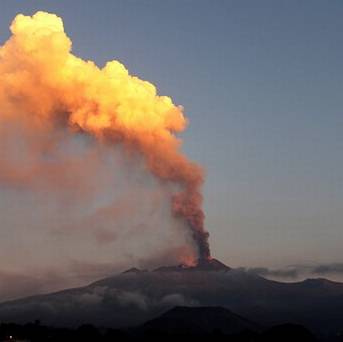
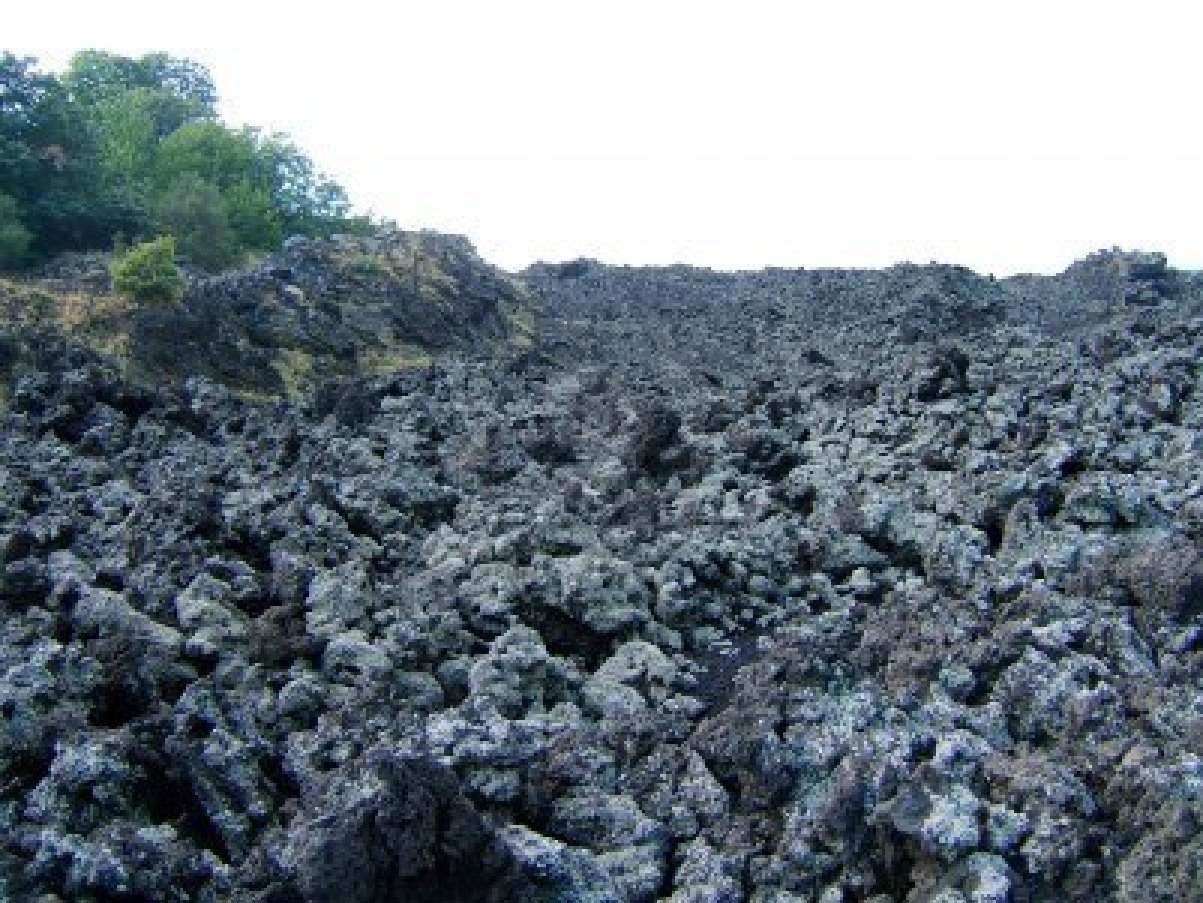
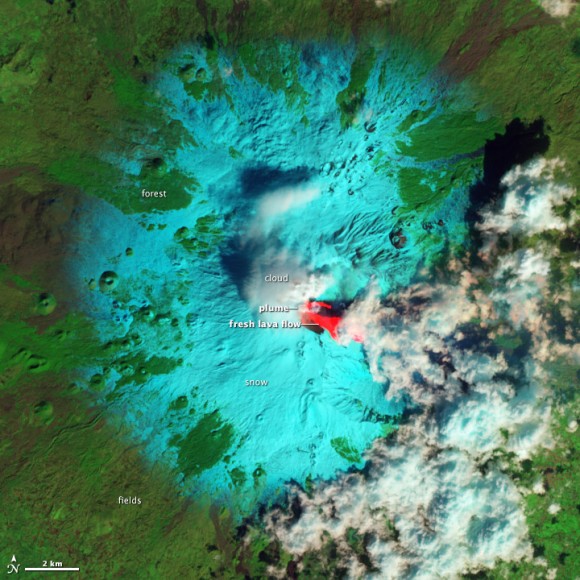
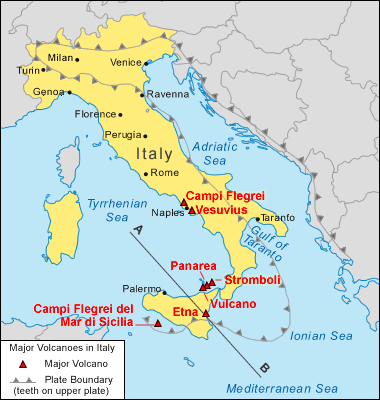
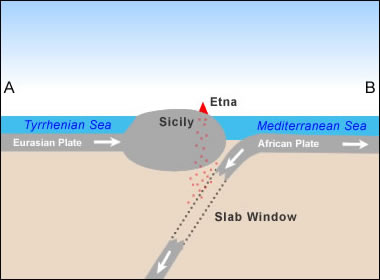
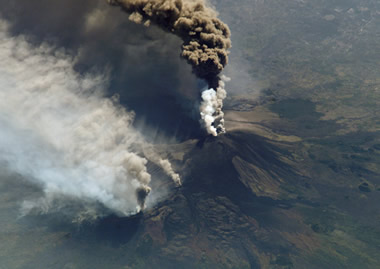




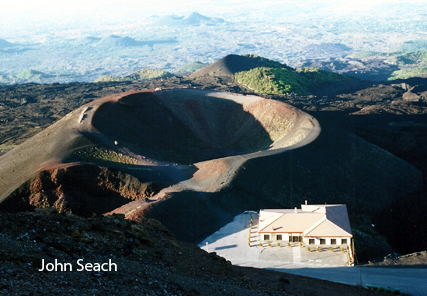
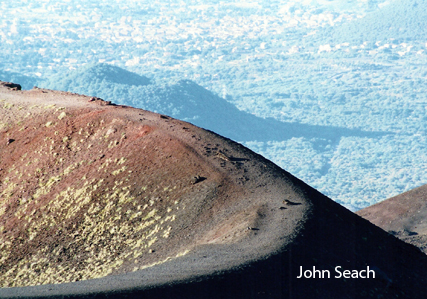
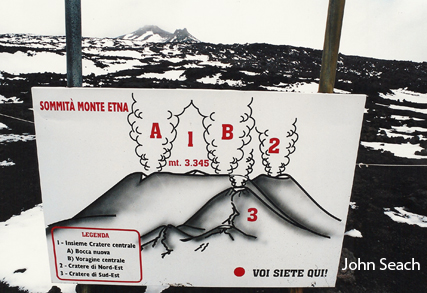

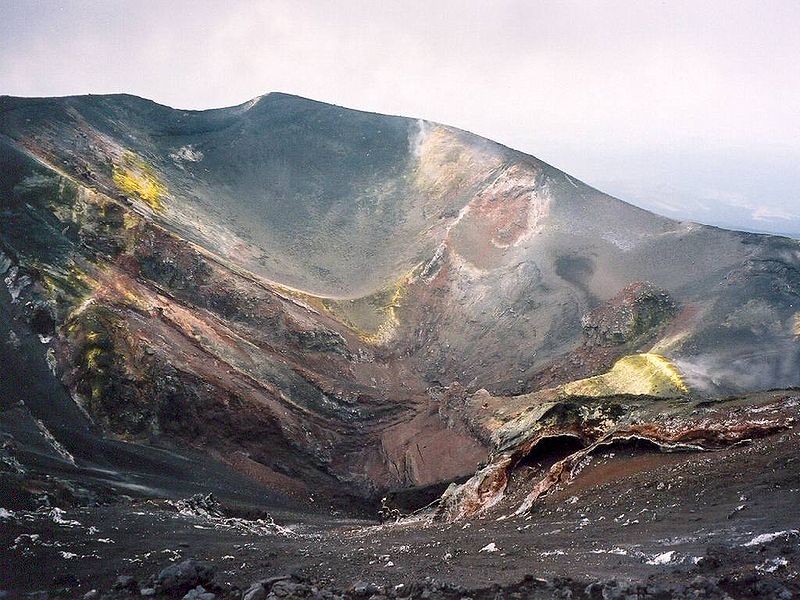















 such
as Patroclos (Patroclus), involved the sacrifice of captives. While the
Celtic sacrifice is connected with the seasons, rebirth, the sacrifice of
the Trojan captives in the
such
as Patroclos (Patroclus), involved the sacrifice of captives. While the
Celtic sacrifice is connected with the seasons, rebirth, the sacrifice of
the Trojan captives in the